Overoxidized polypyrrole graphene nanmposite with good electrochemical performance
- 格式:pdf
- 大小:2.43 MB
- 文档页数:7
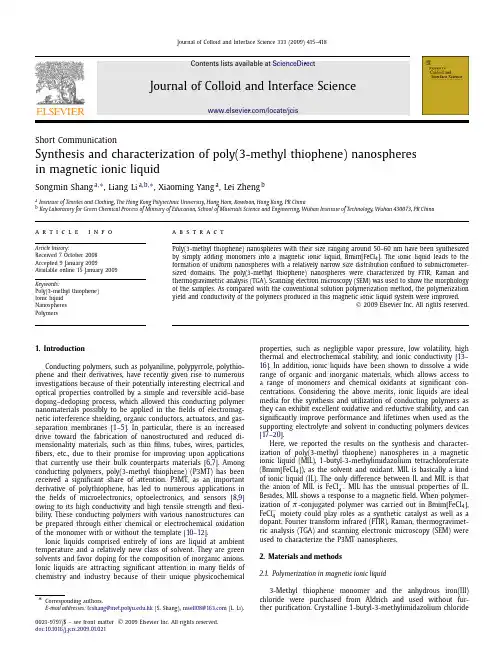
Journal of Colloid and Interface Science333(2009)415–418Contents lists available at ScienceDirectJournal of Colloid and Interface Science/locate/jcisShort CommunicationSynthesis and characterization of poly(3-methyl thiophene)nanospheresin magnetic ionic liquidSongmin Shang a,∗,Liang Li a,b,∗,Xiaoming Yang a,Lei Zheng ba Institute of Textiles and Clothing,The Hong Kong Polytechnic University,Hung Hom,Kowloon,Hong Kong,PR Chinab Key Laboratory for Green Chemical Process of Ministry of Education,School of Materials Science and Engineering,Wuhan Institute of Technology,Wuhan430073,PR China a r t ic l e i n f o a b s t r a c tArticle history:Received7October2008 Accepted9January2009 Available online15January2009Keywords:Poly(3-methyl thiophene)Ionic liquidNanospheresPolymers Poly(3-methyl thiophene)nanospheres with their size ranging around50–60nm have been synthesized by simply adding monomers into a magnetic ionic liquid,Bmim[FeCl4].The ionic liquid leads to the formation of uniform nanospheres with a relatively narrow size distribution confined to submicrometer-sized domains.The poly(3-methyl thiophene)nanospheres were characterized by FTIR,Raman and thermogravimetric analysis(TGA).Scanning electron microscopy(SEM)was used to show the morphology of the samples.As compared with the conventional solution polymerization method,the polymerization yield and conductivity of the polymers produced in this magnetic ionic liquid system were improved.©2009Elsevier Inc.All rights reserved.1.IntroductionConducting polymers,such as polyaniline,polypyrrole,polythio-phene and their derivatives,have recently given rise to numerous investigations because of their potentially interesting electrical and optical properties controlled by a simple and reversible acid–base doping–dedoping process,which allowed this conducting polymer nanomaterials possibly to be applied in thefields of electromag-netic interference shielding,organic conductors,actuators,and gas-separation membranes[1–5].In particular,there is an increased drive toward the fabrication of nanostructured and reduced di-mensionality materials,such as thinfilms,tubes,wires,particles,fibers,etc.,due to their promise for improving upon applications that currently use their bulk counterparts materials[6,7].Among conducting polymers,poly(3-methyl thiophene)(P3MT)has been received a significant share of attention.P3MT,as an important derivative of polythiophene,has led to numerous applications in thefields of microelectronics,optoelectronics,and sensors[8,9] owing to its high conductivity and high tensile strength andflexi-bility.These conducting polymers with various nanostructures can be prepared through either chemical or electrochemical oxidation of the monomer with or without the template[10–12].Ionic liquids comprised entirely of ions are liquid at ambient temperature and a relatively new class of solvent.They are green solvents and favor doping for the composition of inorganic anions. Ionic liquids are attracting significant attention in manyfields of chemistry and industry because of their unique physicochemical*Corresponding authors.E-mail addresses:tcshang@.hk(S.Shang),msell08@(L.Li).properties,such as negligible vapor pressure,low volatility,high thermal and electrochemical stability,and ionic conductivity[13–16].In addition,ionic liquids have been shown to dissolve a wide range of organic and inorganic materials,which allows access to a range of monomers and chemical oxidants at significant con-centrations.Considering the above merits,ionic liquids are ideal media for the synthesis and utilization of conducting polymers as they can exhibit excellent oxidative and reductive stability,and can significantly improve performance and lifetimes when used as the supporting electrolyte and solvent in conducting polymers devices [17–20].Here,we reported the results on the synthesis and character-ization of poly(3-methyl thiophene)nanospheres in a magnetic ionic liquid(MIL),1-butyl-3-methylimidazolium tetrachloroferrate (Bmim[FeCl4]),as the solvent and is basically a kind of ionic liquid(IL).The only difference between IL and MIL is that the anion of MIL is FeCl−4.MIL has the unusual properties of IL. Besides,MIL shows a response to a magneticfield.When polymer-ization ofπ-conjugated polymer was carried out in Bmim[FeCl4],FeCl−4moiety could play roles as a synthetic catalyst as well as a dopant.Fourier transform infrared(FTIR),Raman,thermogravimet-ric analysis(TGA)and scanning electronic microscopy(SEM)were used to characterize the P3MT nanospheres.2.Materials and methods2.1.Polymerization in magnetic ionic liquid3-Methyl thiophene monomer and the anhydrous iron(III) chloride were purchased from Aldrich and used without fur-ther purification.Crystalline1-butyl-3-methylimidazolium chloride0021-9797/$–see front matter©2009Elsevier Inc.All rights reserved. doi:10.1016/j.jcis.2009.01.021416S.Shang et al./Journal of Colloid and Interface Science333(2009)415–418([Bmim]Cl)was prepared according to the standard procedure fol-lowed by repeated recrystallization from dry acetonitrile.The syn-thesis of Bmim[FeCl4]has already been reported in the literature[21,22]and was dried and degassed before use.P3MT nanosphereswere produced by simply adding the monomer to Bmim[FeCl4]asa magnetic ionic liquid solvent.Typically,6mL of Bmim[FeCl4]and2mL of monomer were mixed with stirring.The solutionwas stirred for24h at room temperature,and then the polymerwas removed from the Bmim[FeCl4]solution byfiltering.Thefil-tered P3MT was dried for3h at60◦C in a vacuum oven andfurther purified by methanol washing.Then,P3MT was dried ina vacuum for48h at room temperature.In order to apply mag-neticfield to the polymerization process,two permanent magnetswere used.The glass cell containing Bmim[FeCl4]was sandwichedby two fastened magnets in order to maintain the magneticfieldacross the cell.With the same molar ratio of oxidant to monomer,conventional solution polymerization were also carried out.Themonomer was added into an aqueous solution,then the FeCl3so-lution was introduced into the solution with continuous stirring,and the polymerization reaction proceeded.The obtained poly-mers were washed with water and methanol to remove unreactedchemicals.2.2.CharacterizationFTIR spectra of the composite nanospheres dispersed in KBrdisks were recorded on a Bio-Rad FTS135FTIR spectrophotome-ter.Each spectrum was collected by accumulating64scans at aresolution of4cm−1.Raman spectra were recorded by using amicroscopic confocal Raman spectrometer using a785nm laserbeam and a charge-coupled detector(CCD)with4cm−1reso-lution.TGA was conducted on a Du Pont Thermal Analyst2100system,equipped with a TGA2050thermogravimetric thermal an-alyzer under a nitrogen stream with a heating rate of10◦C/min.Field emission scanning electron microscopy(FESEM)using a JEOLJSM-6700F FESEM was made at an accelerating voltage of5kV.The conductivity of the P3MT nanostructures was measured by theconventional four-probe method.3.Results and discussionThe nanofibers of conducting polymer have been synthesized inthe biphasic ionic liquid/water system[13].The use of ionic liquidsfor the electrochemical synthesis of conducting polymer has alsobeen reported by several groups[17,23],and then IL is used idealmedia for the synthesis of conducting polymer.As shown in Fig.1,the only difference between IL and MIL is that the anion of MIL isFeCl−4.For the preparation of the P3MT nanospheres,Bmim[FeCl4]ionic liquid containing no additional dopants or oxidants was used.Morphology studies of the P3MT nanospheres were carried out by applying SEM.As shown in Fig.2,the obtained nanospheres showed a uniform spherical shape and had an average parti-cle diameter of50–60nm without aggregation.Variation of re-action conditions such as concentration and reaction time did not affect the morphology of the generated conducting polymers. Bmim[FeCl4]solutions seemed to act as a template of liquid phase.IL is not only isotropic organic liquids composed entirely of ions,but it is also anisotropic conductors due to their self-organized structures.The macroscopic orientation ofself-organizedFig. 1.Molecular structure of1-butyl-3-methylimidazolium tetrachloroferrate, Bmim[FeCl4].monodomains in IL may be important in the enhancement of properties because the boundary in randomly oriented domains highly disturbs anisotropic transportation of charges and ions [24].The ionic liquid may result in the formation of uniform nanospheres with a relatively narrow size distribution confined to submicrometer-sized domains.Thus,the structure and properties of P3MT could be ascribed to the structure formation of these MIL molecules with partially oriented anisotropic liquid domain being mixed in isotropic liquids.The effect of external magneticfield was then studied.Fig.2b showed SEM image of P3MTnanostructuresFig.2.SEM images of P3MT nanospheres obtained in MIL(a)without magneticfield and(b)with magneticfield.(c)shows the corresponding size distributions in parti-cle as shown in(a).S.Shang et al./Journal of Colloid and Interface Science333(2009)415–418417Fig.3.FTIR(a)and Raman(b)spectra of P3MT obtained in MIL.synthesized in MIL with magneticfield.When polymerized with-out magneticfield(Fig.2a),spherical P3MT particles were formed as stated above.While interestingly,these nanoparticles seemed to be aligned under magneticfield.The morphology of P3MT changed to a network structure or bridged form of particles,and they were oriented with the direction of the applied magneticfield.Thus,the external magneticfield seems to affect these local structures and thefinal polymer structure.Fig.3showed FTIR and Raman spectra of P3MT obtained in MIL.In the FTIR spectrum(Fig.3a),there were several inten-sity peaks present in the range of2800–3100cm−1,which can be attributed to the C–H stretching vibrations[25].The range of 600–1500cm−1was thefingerprint region of the P3MT.The peak around1355cm−1may be ascribed to the methyl deformation of P3MT.The absorption bands associated with C=C/C–C stretching vibration occurred near around1582and1668cm−1,which may be considered to arise predominantly from both endocyclic and ex-ocyclic double bonds in the oxidized species of polyheterocyclics [26].In the Raman spectrum of P3MT(Fig.3b),the most intense band at around1464cm−1corresponded to the symmetric C=C stretching deformation[27],while the intensity band at1375cm−1Fig.4.TGA curve of P3MT obtained in MIL.was associated with C–C intraring stretching deformations in the aromatic thiophene ring[28].The band at1152cm−1was as-signed to the antisymmetric stretching vibration of C–C bonds[29], whereas another interesting band observed at1223cm−1in P3MT had been attributed to the interring C–C stretching[30].The bands ascribable to the C–H in-plane deformation vibration was observed at1048cm−1[31].The bands at748cm−1were related to C–S–C in-plane deformation[32].To investigate the thermal stability of P3MT obtained in mag-netic ionic liquid,the thermal properties of P3MT were investi-gated,as shown in Fig.4.There were two evident decomposition processes during the thermal degradation of P3MT,and these two decomposition occurred at268and446◦C,respectively.The polymerization yield and conductivity of P3MT could be varied by the synthesis method.The yield in conventional solu-tion polymerization was about28.1%,while the MIL polymerization approach produced62.5%P3MT.The higher polymerization yield of the MIL system may be due to a high local concentration of the monomer in the IL,which accelerated P3MT growth in the IL. However,when MIL after the reaction was re-mixed with the new monomer,the yield was only about12%,much lower than that in thefirst run.It meant that MIL cannot be reused efficiently as ox-idant again,but it still can be reused as solvent.The conductivity of P3MT obtained in MIL was about8.4S cm−1.In comparison,the conductivity of a similar sample prepared through a bulk solution synthesis method with FeCl3as the oxidant was about0.51S cm−1. In general,the conductivities of polymers are related with the synthetic methods,molecule size and structure,arrangement on molecule,kind of dopants and doping degree,etc.In the magnetic ionic liquid polymerization system,P3MT fabricated in MIL may have more attractive well-defined nanostructures,highly organized molecule and high doping degree for high conductivity.4.SummaryA facile and convenient method to synthesize P3MT nano-spheres with their size ranging around50–60nm via polymeriza-tion of monomer in a magnetic ionic liquid without the additional dopant or oxidant was reported.The formation of the polymers was confirmed by SEM,TGA,FTIR and Raman analysis.The yield and conductivity of these P3MT nanospheres obtained in MIL were better than those synthesized in conventional solution polymeriza-tions.Further investigations on effect of many factors,such as tem-perature,magneticfield and structures including the alkyl chain length of the cation,on the preparation and properties of P3MT are in progress.418S.Shang et al./Journal of Colloid and Interface Science333(2009)415–418AcknowledgmentsThe work is supported by the Hubei Province Educational Bu-reau and National Natural Science Foundation of China.References[1]A.Malinauskas,J.Malinauskiene,A.Ramanavicius,Nanotechnology16(2005)R51.[2]J.Lu,K.S.Moon,B.K.Kim,C.P.Wong,Polymer48(2007)1510.[3]G.Sonmez,mun.(2005)5251.[4]R.H.Baughman,C.Cui,A.A.Zakhidov,Z.Iqbal,J.N.Barisci,G.M.Spinks,et al.,Science284(1999)1340.[5]C.A.Amarnath,S.Palaniappan,A.Puzari,P.Rannou, A.Pron,Mater.Lett.61(2007)4204.[6]A.N.Aleshin,Adv.Mater.18(2006)17.[7]P.Leclere,M.Surin,P.Viville,zzaroni,A.F.Kilbinger,O.Henze,et al.,Chem.Mater.16(2004)4452.[8]J.H.Burroughes,D.D.C.Bradley,A.R.Brown,R.N.Marks,K.Mackay,R.H.Friend,P.L.Burn,A.B.Holmes,Nature347(1990)539.[9]H.S.O.Chan,N.S.Choon,Prog.Polym.Sci.23(1998)1167.[10]Y.Berdichevsky,Y.H.Lo,Adv.Mater.18(2006)122.[11]L.Liang,J.Liu,C.F.Windisch,G.J.Exarhos,Y.H.Lin,Angew.Chem.114(2002)3817.[12]N.R.Chiou,C.Lu,J.Guan,L.J.Lee,A.J.Epstein,Nat.Nanotechnol.2(2007)354.[13]T.Welton,Chem.Rev.99(1999)2071.[14]P.Wasserscheid,T.Welton,Ionic Liquids in Synthesis,Wiley–VCH,Weinheim,Germany,2003.[15]J.H.Davis,P.A.Fox,mun.(2003)1209.[16]W.Lu,B.R.Mattes,Synth.Met.152(2005)53.[17]S.Ahmad,M.Deepa,S.Singh,Langmuir23(2007)11430.[18]K.Wagner,J.M.Pringle,S.B.Hall,M.Forsyth, D.R.MacFarlane, D.L.Officer,Synth.Met.153(2005)257.[19]P.Kubisa,J.Polym.Sci.Polym.Chem.43(2005)4675.[20]J.M.Pringle,O.Ngamna,C.Lynam,G.G.Wallace,M.Forsyth,D.R.MacFarlane,Macromolecules40(2007)2702.[21]M.S.Sitze,E.R.Schreiter,E.V.Patterson,R.G.Freeman,Inorg.Chem.40(2001)2298.[22]J.Y.Kim,J.T.Kim,E.A.Song,Y.K.Min,H.Hamaguchi,Macromolecules41(2008)2886.[23]H.Randriamahazaka, C.Plesse, D.Teyssie, C.Chevrot,Electrochim.Acta50(2005)4222.[24]C.M.Gordon,J.D.Holbrey,A.R.Kennedy,K.R.Seddon,J.Mater.Chem.8(1998)2627.[25]Y.D.Wang,M.F.Rubner,Synth.Met.39(1990)153.[26]R.G.Davidson,T.G.Turner,Synth.Met.72(1995)121.[27]J.Casado,V.Hernandez,Y.Kanemitsu,J.T.L.Navarrete,J.Raman Spectrosc.31(2000)565.[28]B.Dufour,P.Rannou,J.P.Travers,A.Pron,M.Zagorska,G.Korc,I.Kulszewicz-Bajer,S.Quillard,S.Lefrant,Macromolecules35(2002)6112.[29]F.Chen,G.Q.Shi,J.X.Zhang,M.X.Fu,Thin Solid Films424(2003)283.[30]E.A.Bazzaoui,J.P.Marsault,S.Aeiyach,caze,Synth.Met.66(1994)217.[31]E.F.Steigmeir,H.Auderset,W.Kobel,D.Baeriswyl,Synth.Met.18(1987)219.[32]G.Louarn,J.P.Buisson,S.Lefrant,D.Fichon,J.Phys.Chem.99(1995)11399.。
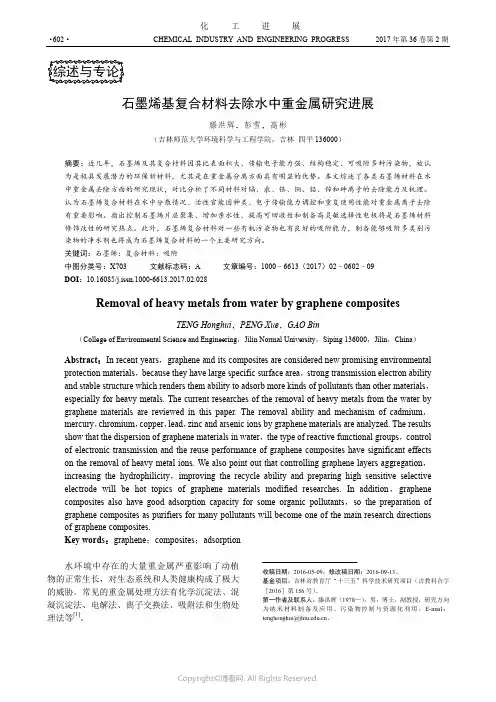
CHEMICAL INDUSTRY AND ENGINEERING PROGRESS 2017年第36卷第2期·602·化 工 进 展石墨烯基复合材料去除水中重金属研究进展滕洪辉,彭雪,高彬(吉林师范大学环境科学与工程学院,吉林 四平136000)摘要:近几年,石墨烯及其复合材料因其比表面积大、传输电子能力强、结构稳定、可吸附多种污染物,被认为是极具发展潜力的环保新材料,尤其是在重金属分离方面具有明显的优势。
本文综述了各类石墨烯材料在水中重金属去除方面的研究现状,对比分析了不同材料对镉、汞、铬、铜、铅、锌和砷离子的去除能力及机理。
认为石墨烯复合材料在水中分散情况、活性官能团种类、电子传输能力调控和重复使用性能对重金属离子去除有重要影响。
指出控制石墨烯片层聚集、增加亲水性、提高可回收性和制备高灵敏选择性电极将是石墨烯材料修饰改性的研究热点。
此外,石墨烯复合材料对一些有机污染物也有良好的吸附能力,制备能够吸附多类别污染物的净水剂也将成为石墨烯复合材料的一个主要研究方向。
关键词:石墨烯;复合材料;吸附中图分类号:X703 文献标志码:A 文章编号:1000–6613(2017)02–0602–09 DOI :10.16085/j.issn.1000-6613.2017.02.028Removal of heavy metals from water by graphene compositesTENG Honghui ,PENG Xue ,GAO Bin(College of Environmental Science and Engineering ,Jilin Normal University ,Siping 136000,Jilin ,China )Abstract :In recent years ,graphene and its composites are considered new promising environmentalprotection materials ,because they have large specific surface area ,strong transmission electron ability and stable structure which renders them ability to adsorb more kinds of pollutants than other materials ,especially for heavy metals. The current researches of the removal of heavy metals from the water by graphene materials are reviewed in this paper. The removal ability and mechanism of cadmium ,mercury ,chromium ,copper ,lead ,zinc and arsenic ions by graphene materials are analyzed. The results show that the dispersion of graphene materials in water ,the type of reactive functional groups ,control of electronic transmission and the reuse performance of graphene composites have significant effects on the removal of heavy metal ions. We also point out that controlling graphene layers aggregation ,increasing the hydrophilicity ,improving the recycle ability and preparing high sensitive selective electrode will be hot topics of graphene materials modified researches. In addition ,graphene composites also have good adsorption capacity for some organic pollutants ,so the preparation of graphene composites as purifiers for many pollutants will become one of the main research directions of graphene composites.Key words :graphene ;composites ;adsorption水环境中存在的大量重金属严重影响了动植物的正常生长,对生态系统和人类健康构成了极大的威胁。
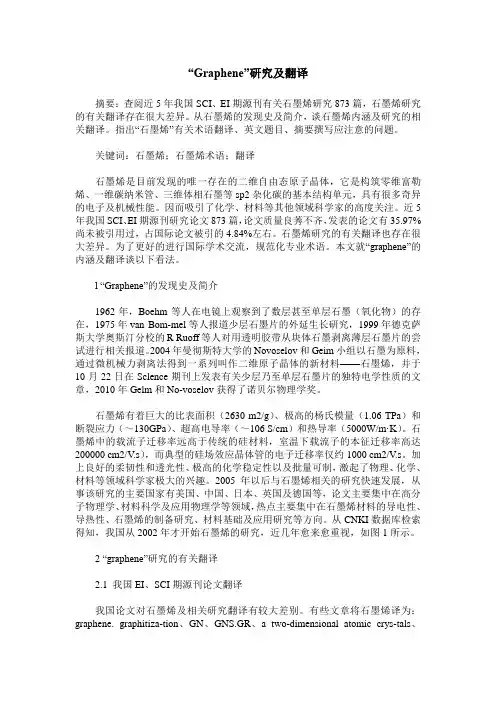
“Graphene”研究及翻译摘要:查阅近5年我国SCI、EI期源刊有关石墨烯研究873篇,石墨烯研究的有关翻译存在很大差异。
从石墨烯的发现史及简介,谈石墨烯内涵及研究的相关翻译。
指出“石墨烯”有关术语翻译、英文题目、摘要撰写应注意的问题。
关键词:石墨烯;石墨烯术语;翻译石墨烯是目前发现的唯一存在的二维自由态原子晶体,它是构筑零维富勒烯、一维碳纳米管、三维体相石墨等sp2杂化碳的基本结构单元,具有很多奇异的电子及机械性能。
因而吸引了化学、材料等其他领域科学家的高度关注。
近5年我国SCI、EI期源刊研究论文873篇,论文质量良莠不齐,发表的论文有35.97%尚未被引用过,占国际论文被引的4.84%左右。
石墨烯研究的有关翻译也存在很大差异。
为了更好的进行国际学术交流,规范化专业术语。
本文就“graphene”的内涵及翻译谈以下看法。
l “Graphene”的发现史及简介1962年,Boehm等人在电镜上观察到了数层甚至单层石墨(氧化物)的存在,1975年van Bom-mel等人报道少层石墨片的外延生长研究,1999年德克萨斯大学奥斯汀分校的R Ruoff等人对用透明胶带从块体石墨剥离薄层石墨片的尝试进行相关报道。
2004年曼彻斯特大学的Novoselov和Geim小组以石墨为原料,通过微机械力剥离法得到一系列叫作二维原子晶体的新材料——石墨烯,并于10月22日在Sclence期刊上发表有关少层乃至单层石墨片的独特电学性质的文章,2010年Gelm和No-voselov获得了诺贝尔物理学奖。
石墨烯有着巨大的比表面积(2630 m2/g)、极高的杨氏模量(1.06 TPa)和断裂应力(~130GPa)、超高电导率(~106 S/cm)和热导率(5000W/m·K)。
石墨烯中的载流子迁移率远高于传统的硅材料,室温下载流子的本征迁移率高达200000 cm2/V.s),而典型的硅场效应晶体管的电子迁移率仅约1000 cm2/V.s。
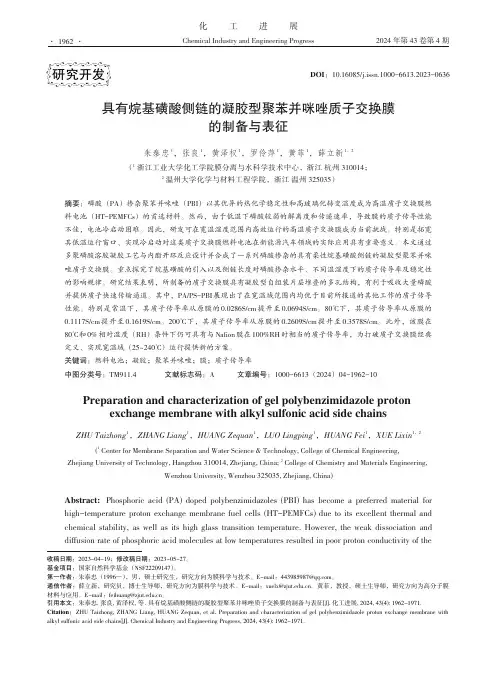
化工进展Chemical Industry and Engineering Progress2024 年第 43 卷第 4 期具有烷基磺酸侧链的凝胶型聚苯并咪唑质子交换膜的制备与表征朱泰忠1,张良1,黄泽权1,罗伶萍1,黄菲1,薛立新1,2(1 浙江工业大学化工学院膜分离与水科学技术中心,浙江 杭州 310014;2温州大学化学与材料工程学院,浙江 温州 325035)摘要:磷酸(PA )掺杂聚苯并咪唑(PBI )以其优异的热化学稳定性和高玻璃化转变温度成为高温质子交换膜燃料电池(HT-PEMFCs )的首选材料。
然而,由于低温下磷酸较弱的解离度和传递速率,导致膜的质子传导性能不佳,电池冷启动困难。
因此,研发可在宽温湿度范围内高效运行的高温质子交换膜成为当前挑战。
特别是拓宽其低温运行窗口、实现冷启动对这类质子交换膜燃料电池在新能源汽车领域的实际应用具有重要意义。
本文通过多聚磷酸溶胶凝胶工艺与内酯开环反应设计并合成了一系列磷酸掺杂的具有柔性烷基磺酸侧链的凝胶型聚苯并咪唑质子交换膜。
重点探究了烷基磺酸的引入以及侧链长度对磷酸掺杂水平、不同温湿度下的质子传导率及稳定性的影响规律。
研究结果表明,所制备的质子交换膜具有凝胶型自组装片层堆叠的多孔结构,有利于吸收大量磷酸并提供质子快速传输通道。
其中,PA/PS-PBI 展现出了在宽温域范围内均优于目前所报道的其他工作的质子传导性能。
特别是常温下,其质子传导率从原膜的0.0286S/cm 提升至0.0694S/cm 。
80℃下,其质子传导率从原膜的0.1117S/cm 提升至0.1619S/cm 。
200℃下,其质子传导率从原膜的0.2609S/cm 提升至0.3578S/cm 。
此外,该膜在80℃和0%相对湿度(RH )条件下仍可具有与Nafion 膜在100%RH 时相当的质子传导率,为打破质子交换膜经典定义、实现宽温域(25~240℃)运行提供新的方案。
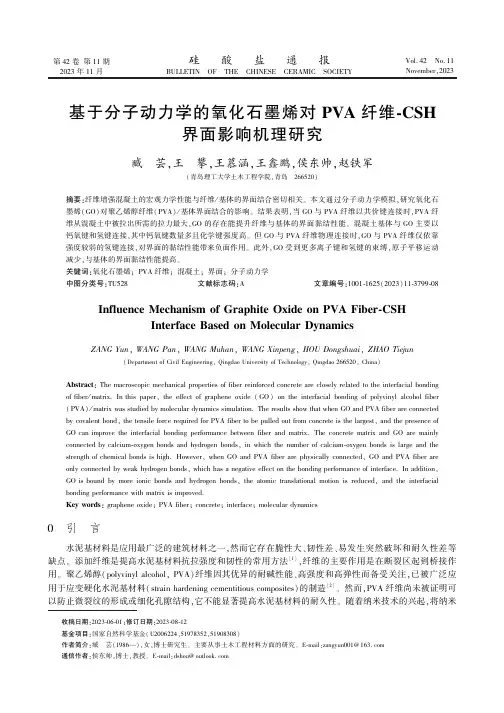
第42卷第11期2023年11月硅㊀酸㊀盐㊀通㊀报BULLETIN OF THE CHINESE CERAMIC SOCIETY Vol.42㊀No.11November,2023基于分子动力学的氧化石墨烯对PVA 纤维-CSH界面影响机理研究臧㊀芸,王㊀攀,王慕涵,王鑫鹏,侯东帅,赵铁军(青岛理工大学土木工程学院,青岛㊀266520)摘要:纤维增强混凝土的宏观力学性能与纤维/基体的界面结合密切相关㊂本文通过分子动力学模拟,研究氧化石墨烯(GO)对聚乙烯醇纤维(PVA)/基体界面结合的影响㊂结果表明,当GO 与PVA 纤维以共价键连接时,PVA 纤维从混凝土中被拉出所需的拉力最大,GO 的存在能提升纤维与基体的界面黏结性能㊂混凝土基体与GO 主要以钙氧键和氢键连接,其中钙氧键数量多且化学键强度高㊂但GO 与PVA 纤维物理连接时,GO 与PVA 纤维仅依靠强度较弱的氢键连接,对界面的黏结性能带来负面作用㊂此外,GO 受到更多离子键和氢键的束缚,原子平移运动减少,与基体的界面黏结性能提高㊂关键词:氧化石墨烯;PVA 纤维;混凝土;界面;分子动力学中图分类号:TU528㊀㊀文献标志码:A ㊀㊀文章编号:1001-1625(2023)11-3799-08Influence Mechanism of Graphite Oxide on PVA Fiber-CSH Interface Based on Molecular DynamicsZANG Yun ,WANG Pan ,WANG Muhan ,WANG Xinpeng ,HOU Dongshuai ,ZHAO Tiejun (Department of Civil Engineering,Qingdao University of Technology,Qingdao 266520,China)Abstract :The macroscopic mechanical properties of fiber reinforced concrete are closely related to the interfacial bonding of fiber /matrix.In this paper,the effect of graphene oxide (GO)on the interfacial bonding of polyvinyl alcohol fiber (PVA)/matrix was studied by molecular dynamics simulation.The results show that when GO and PVA fiber are connected by covalent bond,the tensile force required for PVA fiber to be pulled out from concrete is the largest,and the presence of GO can improve the interfacial bonding performance between fiber and matrix.The concrete matrix and GO are mainly connected by calcium-oxygen bonds and hydrogen bonds,in which the number of calcium-oxygen bonds is large and the strength of chemical bonds is high.However,when GO and PVA fiber are physically connected,GO and PVA fiber are only connected by weak hydrogen bonds,which has a negative effect on the bonding performance of interface.In addition,GO is bound by more ionic bonds and hydrogen bonds,the atomic translational motion is reduced,and the interfacial bonding performance with matrix is improved.Key words :graphene oxide;PVA fiber;concrete;interface;molecular dynamics 收稿日期:2023-06-01;修订日期:2023-08-12基金项目:国家自然科学基金(U2006224,51978352,51908308)作者简介:臧㊀芸(1986 ),女,博士研究生㊂主要从事土木工程材料方面的研究㊂E-mail:zangyun001@通信作者:侯东帅,博士,教授㊂E-mail:dshou@ 0㊀引㊀言水泥基材料是应用最广泛的建筑材料之一,然而它存在脆性大㊁韧性差㊁易发生突然破坏和耐久性差等缺点㊂添加纤维是提高水泥基材料抗拉强度和韧性的常用方法[1],纤维的主要作用是在断裂区起到桥接作用㊂聚乙烯醇(polyvinyl alcohol,PVA)纤维因其优异的耐碱性能㊁高强度和高弹性而备受关注,已被广泛应用于应变硬化水泥基材料(strain hardening cementitious composites)的制造[2]㊂然而,PVA 纤维尚未被证明可以防止微裂纹的形成或细化孔隙结构,它不能显著提高水泥基材料的耐久性㊂随着纳米技术的兴起,将纳米3800㊀水泥混凝土硅酸盐通报㊀㊀㊀㊀㊀㊀第42卷材料(如碳纳米管(carbon nanotubes,CNTs)[3-5]㊁石墨烯和氧化石墨烯(graphene oxide,GO)[6-8])应用于水泥基材料来提高性能已成为近年来新的研究热点㊂与疏水碳纳米管和石墨烯不同,氧化石墨烯引入了含氧基团,如羟基㊁羰基和羧基,是一种优秀的亲水材料[9-10]㊂研究表明,氧化石墨烯的加入可以提高混凝土的抗压抗折强度[11]和耐久性[12-14]㊂因此,利用PVA纤维和氧化石墨烯的协同效应,有望大幅提高水泥基材料的综合性能㊂李相国等[15]研究证明GO复掺PVA纤维可以显著改善水泥基材料孔结构,降低孔隙率,提高水泥基材料抗氯离子渗透性能并降低水泥基材料收缩率㊂Jiang等[16]研究发现在水泥基材料中添加氧化石墨烯可以起到细化孔隙结构的作用,同时提高水化产物在PVA纤维上的黏附性,有利于PVA纤维与水泥基体的结合㊂氧化石墨烯与PVA纤维耦合改性的水泥基材料表现出优异的力学强度和耐久性㊂Yao等[17]利用氧化石墨烯对PVA纤维表面改性,使其化学键能提高80倍以上,混凝土试样抗拉强度提高35.6%㊂然而,GO的存在打破了原有的界面结构,纤维与基体之间的界面变成纤维与GO之间的界面和GO与基体间的界面,界面中化学键的键合也发生了改变㊂在纤维增强水泥基复合材料中,纤维和基体分担载荷,应力通过纤维和基体间的界面传递㊂因此,界面的组成和性能是决定纤维增强水泥基复合材料性能的关键㊂Wang等[18]通过分子动力学分析发现,PVA纤维中的羟基与水化产物中的钙离子可以形成稳定的离子键,因此PVA纤维与水化产物有较好的黏结力㊂GO对界面的影响尚不清晰,而这将直接影响纤维增强水泥基材料的性能㊂本文先通过拉拔模拟计算纤维从界面中拉出所需要的拉拔力,借助力学响应描述界面黏附行为㊂通过静态结构和动态结构分析,探究GO对PVA/CSH界面黏结性能的影响机理㊂本研究有助于指导GO和PVA 在水泥基复合材料中发挥最佳的协同作用㊂1㊀模拟方法1.1㊀模型建立依据Pellenq等[19]和Manzano等[20]提出的方法,基于托贝莫来石(11Å)结构构建了Ca/Si比值为1.7的水化硅酸钙(CSH)模型㊂选取无水托贝莫来石(11Å)层状结构作为建模的初始构型㊂根据硅链的Q n分布结果,随机删除桥接的SiO2和二聚体结构(Si2O4),得到复合硅链的钙硅骨架和层状结构㊂再通过巨正则蒙特卡洛法(GCMC)模拟水分子逐渐吸附在钙硅骨架孔隙上直至饱和这一过程㊂根据液态水在室温下的性质,设定化学势为0,温度为300K,成功建立CSH初始模型,如图1(a)所示㊂根据Allington等[21]提出的方法构建氧化石墨烯模型㊂将石墨烯的单位单元(x=4.62Å,y=3.69Å,z=3.40Å,α=β=γ=90ʎ)在x和y 方向分别扩大,再将环氧( O )㊁羟基( OH)和羧基( COOH)三个官能团修饰到石墨烯上㊂其中 O 和 OH基团分布在石墨烯表面, COOH基团分布在石墨烯边缘,如图1(b)所示㊂氧化石墨烯薄片的化学成分为C10O1(OH)1(COOH)0.5,符合氧化石墨烯典型官能团覆盖率,即含氧量为20%~30%[22]㊂PVA纤维模型如图1(c)所示,每个PVA纤维链具有50个碳原子㊂参照文献[23]结果,本文建立了两种GO/PVA模型:第一种PVA模型如图1(d)所示,GO物理附着在PVA表面,无共价键连接;第二种PVA模型如图1(e)所示,GO与PVA纤维通过脱水缩聚,形成酯基 COO ,使GO与PVA纤维以共价键形式连接㊂因模型中含有多种氧原子和氢原子,为了方便后面的分析将其进行区分㊂O s表示CSH中硅氧四面体中的非桥接氧原子,O hs表示CSH的羟基氧原子,O hp表示PVA纤维中的氧原子,O o表示GO片中C O C中的氧原子, O hg表示GO片中 OH中的氧原子㊂此外, COOH中有两种位置的氧原子,O 表示以双键连接碳的氧原子,O hg表示以单键连接碳的氧原子㊂H op表示PVA纤维中的羟基氢原子,H og表示GO片中含氧官能团中的氢原子㊂从所建立的CSH分子模型层间处切开,并向外平移以预留足够空间插入GO和PVA纤维,并在y方向预留足够的空间保证纤维可以拉出㊂将PVA纤维插入CSH形成的纤维界面定义为界面CP,如图1(f)所示㊂将PVA/GO(物理附着)插入CSH,纤维与GO形成的界面定义为界面CGP1,如图1(g)所示㊂将PVA-GO(形成共价键)插入CSH,纤维与GO成为一体后与CSH形成的界面定义为界面CGP2,如图1(h)所示㊂三个模拟盒子尺寸大小一致,均为x=44.10Å,y=160.70Å,z=67.47Å,α=β=γ=90ʎ㊂㊀第11期臧㊀芸等:基于分子动力学的氧化石墨烯对PVA纤维-CSH界面影响机理研究3801图1㊀氧化石墨烯㊁PVA纤维㊁CSH的结构及连接方式Fig.1㊀Structures and connection modes of graphene oxide,PVA fiber and CSH1.2㊀力㊀场力场的选择对模拟的准确性十分关键,CSH基底采用CLAYFF力场,此力场已被成功用于黏土㊁水泥水化产物㊁多组分矿物体系的模拟[24-25]㊂PVA纤维采用CVFF力场,CVFF已被广泛应用于有机物建模[26-27]㊂CLAYFF与CVFF联合力场已证明适用于模拟胶凝材料与聚合物㊁有机物之间的界面特性[28]㊂此联合力场3802㊀水泥混凝土硅酸盐通报㊀㊀㊀㊀㊀㊀第42卷采用Lorentz-Berthelot 混合规则[29]㊂1.3㊀模拟过程模拟过程分为预平衡阶段㊁平衡阶段和拉拔阶段㊂所有模拟均采用大尺度原子/分子大规模并行模拟器(LAMMPS)平台进行计算㊂所有原子在NPT 系统中弛豫1000ps,时间步长设置为1fs,温度为300K㊂平衡后再运行1000ps,此阶段保持系统与环境变量均不变,每1ps 记录一次轨迹数据,收集到1000帧原子轨迹,用于平衡状态下界面结构和动力学行为分析㊂此后,在NVT 系综下对已经平衡的模型进行拉拔模拟,每根纤维链最右侧的碳原子作为外力的位置[30],时间步长设置为1fs㊂外力和界面能每100s 记录一次㊂拉拔力计算如式(1)所示㊂F =K [(x 0+vt )-x com ](1)式中:F 为拉拔力,x 0为所选碳原子在纤维y 方向上的初始质心,K 为弹簧常数,v 为拉力的速度,t 为模拟时间,x com 为所选碳原子质心沿y 方向的动态位置㊂2㊀结果与讨论2.1㊀拉拔过程图2㊀三个界面的拉力-时间关系Fig.2㊀Pull-out force-time relations of three interfaces 通过拉拔模拟计算得到拉拔力-时间曲线,如图2所示㊂在没有GO 的情况下纤维与CSH 形成界面CP㊂加入GO 后,纤维与GO 形成了新的界面CP1㊂从图2中可以清楚地看到,PVA 纤维从CSH 中被拉出所需要的拉力明显高于PVA /GO 从CSH 中被拉出所需要的拉力,这说明PVA /CSH 的界面黏结力优于PVA /GO界面的黏结力㊂此外,三个界面的拉拔力均波动较大,呈锯齿形逐渐减小㊂在模拟初期,拉拔力逐渐增大,主要原因是化学键的伸长㊂当化学键被过度拉伸直至断裂,拉力会突然下降,在松弛阶段又形成新的化学键,导致拉力再次增大,因此拉拔力呈波动状态㊂随着纤维拉出长度增加,界面处化学键减少,拉拔力逐渐减小㊂由此得出,纤维的拔出过程伴随化学键的断裂和重组㊂图3为拉拔过程第1000ps 快照,从图3(a)中可以发现,GO 与PVA 以物理方式连接时,纤维会从GO 之间很轻易地被拉出,说明GO /PVA 界面的黏结性能很差,GO 的加入对界面的黏结性能起到消极作用㊂如图3(b)所示,在PVA 纤维和GO 以共价键形式连接时,PVA 纤维和GO 作为一个整体同时被拉出㊂PVA-GO 与CSH 形成界面CGP2,此时纤维被拉出所需要的拉力最大,说明CGP2界面的黏结性能最好,GO 的加入对界面的黏结性能起到增强作用㊂图3㊀拉拔过程第1000ps 快照Fig.3㊀Snapshots of pull-out process at 1000ps㊀第11期臧㊀芸等:基于分子动力学的氧化石墨烯对PVA纤维-CSH界面影响机理研究3803 2.2㊀界面静态结构分析径向分布函数(radial distribution function,RDF)表示周围原子出现在中心原子一定范围内的可能性,是原子局部密度与系统的平均密度比值㊂RDF曲线可定性表征配位原子之间的空间相关性,曲线出现峰值的距离越近,表明两原子之间排列更规则,形成的化学键更强,峰值越高说明两原子相关性更高㊂同时,RDF也揭示了界面的连接机制㊂图4为径向分布函数计算结果㊂在CP界面中Ca O hp和氢键的RDF曲线均存在明显的峰值,说明在CSH与PVA纤维之间既存在Ca O hp离子键连接也存在氢键连接,如图4(a)所示㊂而在CP1界面(GO与PVA纤维之间),GO中的氧与PVA纤维中的氢形成脆弱的氢键,如图4(b)所示㊂与氢键相比,离子键的键能远大于氢键㊂键能越大,化学键越牢固,含有该键的分子越稳定,这充分说明了CSH与PVA纤维之间的联系远强于GO与PVA纤维的联系㊂图4㊀CGP1界面㊁CGP2界面和CP界面的径向分布函数Fig.4㊀RDF of CGP1,CGP2and CP interfaces在PVA纤维与GO以共价键连接时,PVA纤维与GO形成一个整体,与CSH之间形成了界面CGP2㊂Ca O o㊁Ca O hg㊁Ca O RDF曲线均存在明显的峰值,如图4(c)所示,这说明GO中的含氧官能团均可以与CSH中的钙离子形成离子键,钙离子与GO中氧原子连接,充当了GO与CSH之间的桥梁㊂其中Ca O hg 和Ca O o的RDF曲线峰值更高,说明离子键中的氧位主要由 OH和 O 提供㊂与CP界面相比,CGP2界面中的Ca O的RDF曲线峰值更高,这是因为在GO中拥有更多能够与CSH中阳离子形成有效化学键的极性位点㊂除了离子键外,界面CP和CGP2中氢键的RDF曲线都有明显的峰值,但在CGP2界面中氢键RDF曲线位置更为靠左,峰值更尖锐,这充分说明在这个界面中有更强的界面成键相互作用,如图4(d)所示㊂根据以上分析可以得出结论,在水泥基质中掺入的GO片可以通过离子键和氢键连接硅酸盐骨架,从而加强了有机相和无机相之间的界面连接㊂在拉拔模拟阶段,纤维从CSH中被拉出的过程中,大量的化学键会被拉伸甚至断裂㊂键长越短,原子核之间的距离越小,键能越大,化学键越稳定,破坏这种化学键需要克服的能量就越多㊂化学键越稳定,对原子3804㊀水泥混凝土硅酸盐通报㊀㊀㊀㊀㊀㊀第42卷运动的阻碍就越大,化学键越难断裂㊂根据前面的分析,在CGP2界面中形成的Ca O离子键和氢键数量最多,稳定性高,这意味着需要克服很大的键能才能将纤维从CSH中拉出㊂而PVA纤维与GO之间只有较弱的氢键,键能很小,较小的拉力就能将纤维拉出㊂拉拔仿真结果与本节分析结果一致㊂键合结构图如图5所示㊂图5㊀界面键合示意图Fig.5㊀Interface bonding diagrams化学键的稳定性可以通过时间相关函数(temporal correlation function,TCF)来描述㊂TCF值接近1,表明化学键稳定㊂如果TCF的值降至零,则说明化学键易断开且不稳定㊂根据前面章节的分析可知,CP界面和CGP2界面是通过Ca O离子键和氢键连接,而CGP1界面仅仅通过氢键将PVA纤维与CSH连接㊂本小节计算了三种界面间的化学键的时间相关函数,计算结果如图6(a)所示㊂在CGP2界面中Ca O键的TCF 值略高于CP界面,这意味着PVA和CSH之间形成的化学键更频繁地断裂和重组㊂在CGP2界面中, Ca O 键㊁Ca O o键和Ca O hg键的TCF值分别稳定在0.80㊁0.90和0.98左右,略有波动㊂与Ca O hg键和Ca O o键的TCF曲线相比,Ca O 键的TCF曲线下降更快,这表明连接GO和CSH的离子键主要由羟基提供氧位㊂这一结果与RDF分析结果一致㊂此外,Ca O键的TCF曲线大都在最初略有下降,然后几乎保持不变㊂这表明CSH中Ca和氧形成的离子键可以长时间连接㊂图6㊀Ca O键和H O键的时间相关函数Fig.6㊀Time correlation function of Ca O and H O bond第11期臧㊀芸等:基于分子动力学的氧化石墨烯对PVA 纤维-CSH 界面影响机理研究3805㊀三个界面中的氢键的TCF 曲线如图6(b)所示㊂相比于Ca O 键,氢键的TCF 曲线明显下降得更快,这也证明了离子键在界面连接中起到主导作用㊂界面之间化学键稳定性的差异解释了纤维与基体之间相互作用的差异㊂PVA 纤维和GO 之间没有稳定的离子键连接,导致PVA 纤维更容易被拉出㊂界面动态分析表明,三种界面结合强度依次为:CGP2>CP >CGP1,这说明如果GO 与PVA 纤维之间没有形成共价键,而只是以物理形式附着在PVA 纤维表面,不利于提升界面黏结性能,当PVA 纤维与GO 以共价键形式连接时,GO 才能发挥拥有更多极性氧位的优势,对界面的黏结性能才能起到增强作用㊂这与试验中的结果保持一致[23]㊂图7㊀不同界面的黏附能Fig.7㊀Adhesion energy of different interfaces 作用在PVA 纤维上的恢复力来自界面的相互作用,由黏附能提供[31]㊂在分子水平上,黏附能也可以用作表征界面黏结性能的参数㊂在CSH /PVA 模型中,只有存在CP (CSH /PVA)界面㊂而在CSH /GO /PVA 模型中虽然存在两个界面CSH /GO 和GO /PVA,但根据2.1节的分析,当纤维被拔出时,对纤维拉出行为产生影响的是GO /PVA 界面,所以仅计了CGP1(GO /PVA)界面的黏附能㊂在CSH /GO-PVA 模型中,GO 与PVA 纤维以共价键连接,只有界面CGP2(GO /CSH)影响到纤维被拉出行为㊂界面黏附能计算结果如图7所示,CGP1界面的黏附能仅为1979.3kcal /mol(1kJ =4.184kcal),而CP 界面的黏附能为3780.7kcal /mol,明显比界面CGP1要高出很多,这说明CSH /PVA 界面有更强的相互作用㊂CGP2界面的黏附能绝对值最大,为5515.9kcal /mol,这意味着当GO 与PVA 纤维形成共价键连接时,GO 对界面黏结性能起到增强作用㊂3㊀结㊀论1)PVA /CSH 界面主要是以钙氧离子键和氢键连接,而PVA /GO 界面仅依靠氢键连接㊂2)CGP2界面的黏结性能优于CP 界面和CGP1界面,其中CGP1界面的黏结性能最差㊂3)当PVA 纤维与GO 以共价键方式连接时,GO 发挥多极性氧位的优势,与CSH 之间形成更强的键合作用,从而加强了有机相和无机相之间的界面连接㊂当GO 以物理形式附着在PVA 纤维表面时,对界面的黏结性能起负面作用㊂参考文献[1]㊀杨宇林.纤维混凝土复合材料耐久性能研究综述[J].混凝土,2012(2):78-80+85.YANG Y L.Review on durability of complex fiber concrete[J].Concrete,2012(2):78-80+85(in Chinese).[2]㊀KANDA T,LI V C.Practical design criteria for saturated pseudo strain hardening behavior in ECC [J].Journal of Advanced ConcreteTechnology,2006,4(1):59-72.[3]㊀KONSTA-GDOUTOS M S,METAXA Z S,SHAH S P.Multi-scale mechanical and fracture characteristics and early-age strain capacity of highperformance carbon nanotube /cement nanocomposites[J].Cement and Concrete Composites,2010,32(2):110-115.[4]㊀KONSTA-GDOUTOS M S,METAXA Z S,SHAH S P.Highly dispersed carbon nanotube reinforced cement based materials[J].Cement andConcrete Research,2010,40(7):1052-1059.[5]㊀SUN G X,LIANG R,LU Z Y,et al.Mechanism of cement /carbon nanotube composites with enhanced mechanical properties achieved byinterfacial strengthening[J].Construction and Building Materials,2016,115:87-92.[6]㊀PAN Z,HE L,QIU L,et al.Mechanical properties and microstructure of a graphene oxide-cement composite [J].Cement and ConcreteComposites,2015,58:140-147.[7]㊀LV S H,MA Y J,QIU C C,et al.Effect of graphene oxide nanosheets of microstructure and mechanical properties of cement composites[J].Construction and Building Materials,2013,49:121-127.[8]㊀LU Z Y,HOU D S,MA H Y,et al.Effects of graphene oxide on the properties and microstructures of the magnesium potassium phosphate3806㊀水泥混凝土硅酸盐通报㊀㊀㊀㊀㊀㊀第42卷cement paste[J].Construction and Building Materials,2016,119:107-112.[9]㊀GEIM A K,NOVOSELOV K S.The rise of graphene[J].Nature Materials,2007,6(3):183-191.[10]㊀LU Z Y,CHEN G C,HAO W B,et al.Mechanism of UV-assisted TiO2/reduced graphene oxide composites with variable photodegradation ofmethyl orange[J].RSC Advances,2015,5(89):72916-72922.[11]㊀LONG W J,WEI J J,MA H Y,et al.Dynamic mechanical properties and microstructure of graphene oxide nanosheets reinforced cementcomposites[J].Nanomaterials,2017,7(12):407.[12]㊀何㊀威,许吉航.少层石墨烯对普通混凝土性能的影响[J].硅酸盐通报,2021,40(5):1477-1488.HE W,XU J H.Effect of few-layer graphene on properties of ordinary concrete[J].Bulletin of the Chinese Ceramic Society,2021,40(5): 1477-1488(in Chinese).[13]㊀陈㊀旭,汉光昭,裴玉胜,等.不同含量石墨烯对混凝土抗冻性能的影响[J].建筑施工,2021,43(8):1659-1663.CHEN X,HAN G Z,PEI Y S,et al.Influence of different content of graphene on frost resistance of concrete[J].Building Construction,2021, 43(8):1659-1663(in Chinese).[14]㊀徐义洪,范颖芳.氧化石墨烯分散液对混凝土抗盐冻性能的影响[J].混凝土,2022(2):1-5.XU Y H,FAN Y F.Effects of graphene oxide dispersion on the salt-frost resistance of concrete[J].Concrete,2022(2):1-5(in Chinese).[15]㊀李相国,任钊锋,徐朋辉,等.氧化石墨烯复合PVA纤维增强水泥基材料的力学性能及耐久性研究[J].硅酸盐通报,2018,37(1):245-250.LI X G,REN Z F,XU P H,et al.Research on mechanical properties and durability of graphene oxide composite PVA fiber reinforced cement-based material[J].Bulletin of the Chinese Ceramic Society,2018,37(1):245-250(in Chinese).[16]㊀JIANG W G,LI X G,LV Y,et al.Cement-based materials containing graphene oxide and polyvinyl alcohol fiber:mechanical properties,durability,and microstructure[J].Nanomaterials,2018,8(9):638.[17]㊀YAO X P,SHAMSAEI E,CHEN S J,et al.Graphene oxide-coated poly(vinyl alcohol)fibers for enhanced fiber-reinforced cementitiouscomposites[J].Composites Part B:Engineering,2019,174:107010.[18]㊀WANG P,QIAO G,ZHANG Y,et al.Molecular dynamics simulation study on interfacial shear strength between calcium-silicate-hydrate andpolymer fibers[J].Construction and Building Materials,2020,257:119557.[19]㊀PELLENQ R J M,KUSHIMA A,SHAHSAVARI R,et al.A realistic molecular model of cement hydrates[J].Proceedings of the NationalAcademy of Sciences of the United States of America,2009,106(38):16102-16107.[20]㊀MANZANO H,MOEINI S,MARINELLI F,et al.Confined water dissociation in microporous defective silicates:mechanism,dipole distribution,and impact on substrate properties[J].Journal of the American Chemical Society,2012,134(4):2208-2215.[21]㊀ALLINGTON R D,ATTWOOD D,HAMERTON I,et al.A model of the surface of oxidatively treated carbon fibre based on calculations ofadsorption interactions with small molecules[J].Composites Part A:Applied Science and Manufacturing,1998,29(9/10):1283-1290. [22]㊀JIAO S P,XU Z P.Selective gas diffusion in graphene oxides membranes:a molecular dynamics simulations study[J].ACS Applied Materials&Interfaces,2015,7(17):9052-9059.[23]㊀LU C,LU Z Y,LI Z J,et al.Effect of graphene oxide on the mechanical behavior of strain hardening cementitious composites[J].Constructionand Building Materials,2016,120:457-464.[24]㊀WANG P,QIAO G,HOU D S,et al.Functionalization enhancement interfacial bonding strength between graphene sheets and calcium silicatehydrate:insights from molecular dynamics simulation[J].Construction and Building Materials,2020,261:120500.[25]㊀SHAHRIYARI R,KHOSRAVI A,AHMADZADEH A.Nanoscale simulation of Na-Montmorillonite hydrate under basin conditions,application ofCLAYFF force field in parallel GCMC[J].Molecular Physics,2013,111(20):3156-3167.[26]㊀KUNDALWAL S,KUMAR S.Multiscale modeling of stress transfer in continuous microscale fiber reinforced composites with nano-engineeredinterphase[J].Mechanics of Materials,2016,102:117-131.[27]㊀KUNDALWAL S,MEGUID S.Multiscale modeling of regularly staggered carbon fibers embedded in nano-reinforced composites[J].EuropeanJournal of Mechanics-A Solids,2017,64:69-84.[28]㊀HOU D S,YANG Q R,JIN Z Q,et al.Enhancing interfacial bonding between epoxy and CSH using graphene oxide:an atomistic investigation[J].Applied Surface Science,2021,568:150896.[29]㊀ALLEN M P,TILDESLEY D puter simulation of liquids[M].New York:Oxford University Press,2017.[30]㊀LU Z,YU J,YAO J,et al.Experimental and molecular modeling of polyethylene fiber/cement interface strengthened by graphene oxide[J].Cement and Concrete Composites,2020(112):103676.[31]㊀LI X Y,LU Z Y,CHUAH S,et al.Effects of graphene oxide aggregates on hydration degree,sorptivity,and tensile splitting strength of cementpaste[J].Composites Part A:Applied Science and Manufacturing,2017,100:1-8.。
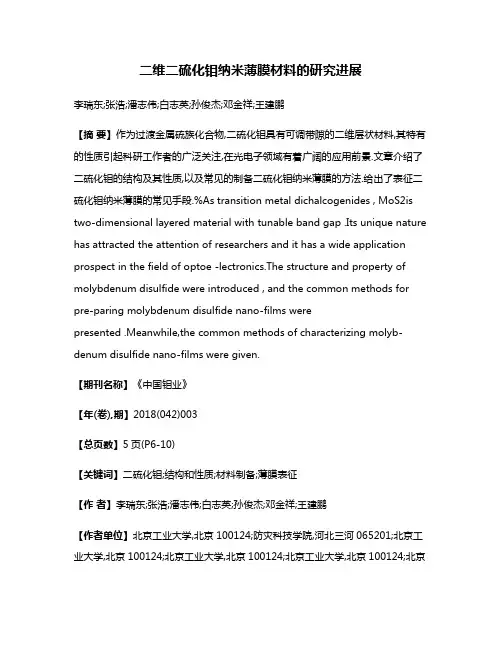
二维二硫化钼纳米薄膜材料的研究进展李瑞东;张浩;潘志伟;白志英;孙俊杰;邓金祥;王建鹏【摘要】作为过渡金属硫族化合物,二硫化钼具有可调带隙的二维层状材料,其特有的性质引起科研工作者的广泛关注,在光电子领域有着广阔的应用前景.文章介绍了二硫化钼的结构及其性质,以及常见的制备二硫化钼纳米薄膜的方法.给出了表征二硫化钼纳米薄膜的常见手段.%As transition metal dichalcogenides , MoS2is two-dimensional layered material with tunable band gap .Its unique nature has attracted the attention of researchers and it has a wide application prospect in the field of optoe -lectronics.The structure and property of molybdenum disulfide were introduced , and the common methods for pre-paring molybdenum disulfide nano-films werepresented .Meanwhile,the common methods of characterizing molyb-denum disulfide nano-films were given.【期刊名称】《中国钼业》【年(卷),期】2018(042)003【总页数】5页(P6-10)【关键词】二硫化钼;结构和性质;材料制备;薄膜表征【作者】李瑞东;张浩;潘志伟;白志英;孙俊杰;邓金祥;王建鹏【作者单位】北京工业大学,北京100124;防灾科技学院,河北三河065201;北京工业大学,北京100124;北京工业大学,北京100124;北京工业大学,北京100124;北京工业大学,北京100124;北京工业大学,北京100124;河北省地矿局第七地质大队,河北三河065201【正文语种】中文【中图分类】TF125.2+410 引言二维材料是指由单原子层或少数原子层构成的晶体材料,其概念可以追溯到十九世纪初期。
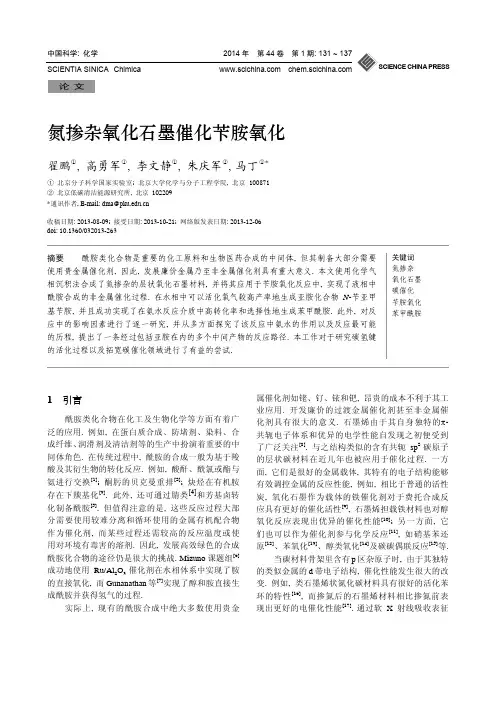
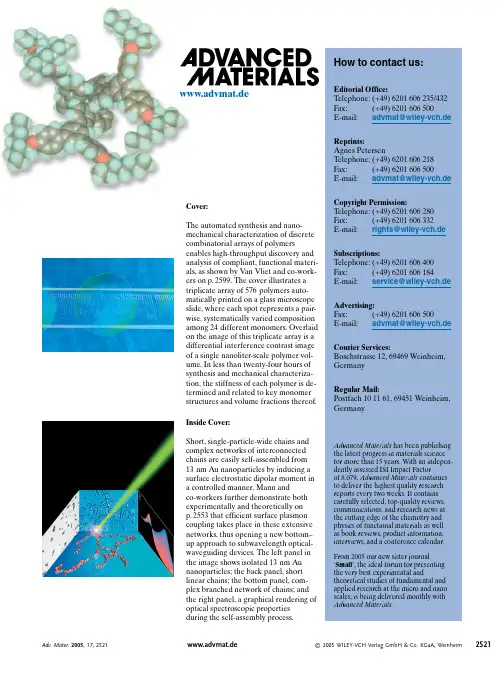
Adv.Mater.2005,17,2521www.advmat.de©2005WILEY-VCH Verlag GmbH &Co.KGaA,Weinheim2521How to contact us:Editorial Office:Telephone:(+49)6201606235/432Fax:(+49)6201606500E-mail:advmat@wiley-vch.de Reprints:Agnes PetersenTelephone:(+49)6201606218Fax:(+49)6201606500E-mail:advmat@wiley-vch.de Copyright Permission:Telephone:(+49)6201606280Fax:(+49)6201606332E-mail:rights@wiley-vch.de Subscriptions:Telephone:(+49)6201606400Fax:(+49)6201606184E-mail:service@wiley-vch.de Advertising:Fax:(+49)6201606500E-mail:advmat@wiley-vch.de Courier Services:Boschstrasse 12,69469Weinheim,GermanyRegular Mail:Postfach 101161,69451Weinheim,GermanyAdvanced Materials has been publishing the latest progress in materials science for more than 15years.With an indepen-dently assessed ISI Impact Factorof 8.079,Advanced Materials continues to deliver the highest quality research reports every two weeks.It containscarefully selected,top-quality reviews,communications,and research news at the cutting edge of the chemistry and physics of functional materials as well as book reviews,product information,interviews,and a conference calendar.From 2005our new sister journal‘Small ’,the ideal forum for presenting the very best experimental andtheoretical studies of fundamental and applied research at the micro and nano scales,is being delivered monthly with Advanced Materials .www.advmat.deCover:The automated synthesis and nano-mechanical characterization of discrete combinatorial arrays of polymersenables high-throughput discovery and analysis of compliant,functional materi-als,as shown by Van Vliet and co-work-ers on p.2599.The cover illustrates a triplicate array of 576polymers auto-matically printed on a glass microscope slide,where each spot represents a pair-wise,systematically varied composition among 24different monomers.Overlaid on the image of this triplicate array is a differential interference contrast image of a single nanoliter-scale polymer vol-ume.In less than twenty-four hours of synthesis and mechanical characteriza-tion,the stiffness of each polymer is de-termined and related to key monomer structures and volume fractions thereof.Inside Cover:Short,single-particle-wide chains and complex networks of interconnected chains are easily self-assembled from 13nm Au nanoparticles by inducing a surface electrostatic dipolar moment in a controlled manner.Mann andco-workers further demonstrate both experimentally and theoretically on p.2553that efficient surface plasmon coupling takes place in these extensive networks,thus opening a new bottom–up approach to subwavelength optical-waveguiding devices.The left panel in the image shows isolated 13nm Au nanoparticles;the back panel,short linear chains;the bottom panel,com-plex branched network of chains;and the right panel,a graphical rendering of optical spectroscopic properties during the self-assembly process.Editor:Esther Levy Deputy Editor:Karen Grieve Associate Editors:David Flanagan,Cara Mulcahy,Soraya ReidenbachAssistant Editors:Mary Farrell,Lisa WylieProduction:Agnes Petersen Administration:Ramona Nily,Melanie Schmitt,Susanne StollMarketing:Claudia Barzen Freelance Cartoonist:Philip Harms Editorial Office:Tel.(+49)6201606235/432Fax (+49)6021606500E-mail:advmat@wiley-vch.de Subscription Service:Tel.(+49)6201606400Fax (+49)6021606184E-mail:service@wiley-vch.de Order through your bookseller or directly at the Publisher:Wiley-VCH,P .O.Box 101161,D-69451Weinheim,Germany.Tel.(+49)6201606400Fax (+49)6201606184E-mail:service@wiley-vch.de Published 24times a year by WILEY-VCH Verlag GmbH &Co.KGaAD-69469Weinheim,GermanyAdvisory Board P .M.Ajayan,Rensselaer Polytechnic Inst.P .Batail,Angers M.T.Bernius,DowP .W.M.Blom,GroningenP .D.Calvert,Univ.of Massachusetts J.Caro,HannoverJ.H.Fendler,Clarkson S.Forrest,Princeton R.H.Friend,Cambridge R.C.Haddon,UC Riverside P .T.Hammond,MIT A.Hirsch,Erlangen H.van Houten,Philips J.Hulliger,BernT.Hyeon,Seoul Natl.Univ.A.C.Jones,Inorgtech D.L.Kaplan,Tufts T.Kato,Tokyohav,Weizmann Inst.Sci.S.Mann,BristolC.R.Martin,Univ.of Florida R.D.McCullough,Carnegie MellonE.W.Meijer,Eindhoven ler,UtahC.A.Mirkin,Northwestern W.S.Rees,Georgia Tech J.Rieger,BASFM.J.Sailor,UC San Diego F.Schüth,MPI Mülheim Y.Shirota,FukuiM.Steigerwald,Columbia S.Subramoney,DuPont G.Wegner,MPI MainzBooks for review:Uninvited copies not chosen for review will not be returned.Manuscript Submission &PersonalHomepage:Typeset by kühn &weyhSatz und Medien,Freiburg,Germany.Printed by Druckhaus Darmstadt GmbH,Darmstadt,Germany.Printed on acid-free paper.©2005Wiley-VCH Verlag GmbH &Co.KGaA,D-69469Weinheim,Germany.All rights reserved (including those of translation into foreign languages).No part of this issue may be reproduced in any form –by photoprint,microfilm,or any other means –nor transmitted or translated into a machine language without written permission from the publishers.Only single copies of contribu-tions,or parts thereof,may be made for personal use.This journal was carefully produced in all its parts.Nevertheless,authors,editors,and publisher do not guarantee the information contained therein to be free of errors.Registered names,trademarks,ed in this journal,even when not marked as such,are not to be considered unprotected by law.Valid for users in the USA:The copyright owner agrees that copies of the articles may be made for personal or internal use,or for the personal or inter-nal use of specific clients.This consent is given on the condition,however,that the copier pay the stat-ed per-copy fee through the Copyright Clearance Center,Inc.(CCC)for copying beyond that per-mitted by Sections 107or 108of the U.S.Copyright Law.This consent does not extend to other kinds of copying,such as copying for general distribtion,for advertising or promotional purposes,for creating new collective works,or for resale.For copying from back volumes of this journal see ‘Permissions to Photo Copy:Publisher’s Fee List’of theCCC.Annual subscription rates 2006PersonalInstitutional*Europe EUR 298EUR 3078/3386Switzerland SFr 638SFr 4818/5300Outside EuropeUS$418US$3958/4354*Print or electronic delivery/print +electronic delivery First-time personal rates are available on request.10%discount if ordered in combination with Advanced Functional Materials.Postage and handling charges included.For the USA and Canada:ADVANCED MATERIALS (Print ISSN 0935-9648,Online ISSN 1521-4095)is published semimonthly by Wiley-VCH,P .O.Box 101161,D-69451Weinheim,Germany.Air freight and mailing in the USAby Publications Expediting Services Inc.,200Meacham Ave.,Elmont,NY 11003.Periodical postage paid at Jamaica,NY Postmaster:Send address changes to:“Advanced Materials”c/o Wiley-VCH,111River Street,Hoboken,NJ 07030.Adv.Mater.2005,17,2523–2529www.advmat.de©2005WILEY-VCH Verlag GmbH &Co.KGaA,Weinheim2523Upcoming ArticlesG.L.Liu,Y.Lu,J.Kim,J.C.Doll,L.P .Lee*Magnetic Nanocrescents as Controllable Surface-Enhanced Raman Scattering Nanoprobes for Biomolecular ImagingPublished Online:September 29,2005DOI:10.1002/adma.200501064X.Liu,J.Ly,S.Han,D.Zhang,A.Requicha,M.E.Thompson,C.Zhou*Synthesis and Electronic Properties of Individual Single-Walled Carbon Nanotube/Polypyrrole Composite NanocablesPublished Online:September 29,2005DOI:10.1002/adma.200501211S.W.Lee,R.G.Sanedrin,B.-K.Oh,C.A.Mirkin*Nanostructured Polyelectrolyte Mul-tilayer Organic Thin Films Generated via Parallel Dip-Pen Nanolithography Published Online:September 29,2005DOI:10.1002/adma.200501120N.Tétreault,G.von Freymann,M.Deubel,M.Hermatschweiler,F.Pérez-Willard,S.John,M.Wegener,G.A.Ozin*New Route to Three-Dimensional Photonic Bandgap Materials:Silicon Double Inversion of Polymer TemplatesPublished Online:September 26,2005DOI:10.1002/adma.200501674All our articles are available online in advance of print.The articles listed here have been judged by the referees or the editor to be either very important or very urgent and were immediately copyedited,proofread,and published online when the manuscript arrived in the editorial office in its final form.As long as there is no page number available,online manuscripts should be cited in the following manner:Authors,Adv.Mater.,online publication date,DOI.REVIEWNanocrystalsD.Kovalev,*M.Fujii ........2531–2544Silicon Nanocrystals:Photosensitizers for OxygenMoleculesThe features of nanoscale silicon that make it different from the bulk result in very efficient energy transfer from excitons confined in silicon nanocrystals to oxygen molecules following their activation to the highly reactive singlet state (see Figure).The mechanism for the photosensitization of oxygen molecules using silicon nanocrystals is reviewed.We discuss,in addition,the implications of these findings for physics,chemistry,biology,and medicine.COMMUNICATIONSMagnetic MaterialsC.Enkrich,F.Pérez-Willard,D.Gerthsen,J.F.Zhou,T.Koschny,C.M.Soukoulis,M.Wegener,S.Linden*...2547–2549Focused-Ion-Beam Nanofabrication of Near-Infrared MagneticMetamaterialsSplit-ring resonators with a magnetic resonance in the near-infrared have been fabricated using the rapid-prototyping capabilities of focused-ion-beam writing.By varying the design parameters,a continuous transition from a degenerate Mie resonance to a magnetic-dipole response is shown (see Figure).In particular,a negative magnetic permeability at a wavelength of 2.4 m and a negative magneticsusceptibility at a wavelength of 1.7 m are demonstrated.Organic SemiconductorsA.Brillante,*I.Bilotti,R.G.Della Valle,E.Venuti,M.Masino,A.Girlando...2549–2553 Characterization of Phase Purity in Organic Semiconductors by Lattice-Phonon Confocal Raman Mapping: Application toPentacene Lattice-phonon confocal Raman mapping is a powerful technique to probe the crystal structure of poly-morphs of organic semiconductors.This technique is fast,reliable,and capable of monitoring physical modifications and phase inhomogeneities in crystal do-mains at the micrometer scale.Applying the technique to pentacene crystals (see Figure)shows that phase inhomo-geneities are not confined to the crystal surface,but penetrate into the crystal.Nanoparticle AssemblyS.Lin,M.Li,E.Dujardin,*C.Girard,S.Mann*..........2553–2559 One-Dimensional Plasmon Coupling by Facile Self-Assembly of Gold Nanoparticles into Branched ChainNetworks Short chains and complex networks of interconnected Au nanoparticle chains (see Figure)are produced by a simple template-free approach.Optical spectroscopy and computer simulations show that surface plasmons from individual non-contacting nanoparticles are strongly coupled in the resulting1D superstructures.These chains may pro-vide a unique way to fabricate complex subwavelength optical waveguides.NanopatterningJ.H.Moon,S.G.Jang,J.-M.Lim,S.-M.Yang*.......................2559–2562 Multiscale Nanopatterns Templated from Two-Dimensional Assembliesof PhotoresistParticles Multiscale nanopatterns fabricated by colloidal lithography,using two-dimen-sional self-assemblies of photoresist particles as masks,are presented.The colloidal masks with features of multiple length scales are obtained by photolithography and used for con-structing submicrometer-hole arrays over large areas(see Figure).By depositing functional materials through these masks,nanopatterned substrates useful in a wide range of applications can be produced.NanostructuresC.Lu,L.Qi,*J.Yang,X.Wang,D.Zhang,J.Xie,J.Ma.....2562–2567 One-Pot Synthesis of Octahedral Cu2O Nanocages via a Catalytic SolutionRoute Unique single-crystalline octahedralCu2O nanocages(see Figure)are synthesized in solution by the catalytic reduction of copper tartrate complex into octahedral Cu2O nanocrystals and a subsequent spontaneous hollowing process.A wealth of colorful nanostruc-tures with widely tunable bandgaps in the range2.6–2.2eV are obtained.The obtained nanocages may find potential use in solar-energy conversion,catalysis, and as model systems for fundamental research.2524©2005WILEY-VCH Verlag GmbH&Co.KGaA,Weinheim www.advmat.de Adv.Mater.2005,17,2523–2529Adv.Mater.2005,17,2523–2529www.advmat.de©2005WILEY-VCH Verlag GmbH &Co.KGaA,Weinheim2525PhotolithographyC.Sánchez,B.-J.de Gans,D.Kozodaev,A.Alexeev,M.J.Escuti,C.van Heesch,T.Bel,U.S.Schubert,C.W.M.Bastiaansen,*D.J.Broer ..........................2567–2571Photoembossing of Periodic Relief Structures Using Polymerization-Induced Diffusion:A CombinatorialStudyPhotoembossing is a solvent-free photo-lithographic technique for the produc-tion of polymeric relief microstructures (see Figure).A combinatorial method-ology to explore the influence of differ-ent parameters (e.g.,processing temper-ature,binder content,photoinitiator content)on the resultant relief structure is presented using an acrylate-based model system.Results are discussed in the framework of a diffusion-polymer-ization model.BiomineralizationM.Umetsu,M.Mizuta,K.Tsumoto,S.Ohara,S.Takami,H.Watanabe,I.Kumagai,T.Adschiri*..2571–2575Bioassisted Room-TemperatureImmobilization and Mineralization of Zinc Oxide—The Structural Ordering of ZnO Nanoparticles into a Flower-TypeMorphologyA peptide with an affinity for ZnO,selected by a phage-display system,pref-erentially immobilizes ZnO particles on a gold-coated polypropylene plate and assists in the homogeneous assembly of 10nm diameter ZnO nanoparticles into unique flower-like morphologies(see Figure).The peptide is selective in binding ZnO,but not ZnS or Eu 2O 3.This combinatorial library approach may yield new peptides used to create new structures via biomineralization.MicropatterningJ.Park,L.D.Fouché,P .T.Hammond*...............2575–2579Multicomponent Patterning of Layer-by-Layer Assembled Polyelectrolyte/Nanoparticle Composite Thin Films with ControlledAlignmentComposite thin films of polyelectrolytes and fluorescent nanoparticles can be directly transfer-printed onto various substrates including indium tin oxide coated poly(ethylene terephthalate).The sequential transfer printing of thin films with controlled alignment intro-duces multicomponent patterns onto substrates,demonstrating possible practical device fabrication using functional polyelectrolyte multilayer composite thin films (see Figure).Liquid CrystalsZ.An,J.Yu,S.C.Jones,S.Barlow,S.Yoo,B.Domercq,P .Prins,L.D.A.Siebbeles,B.Kippelen,S.R.Marder*....................2580–2583High Electron Mobility in Room-Temperature DiscoticLiquid-Crystalline Perylene DiimidesPerylene diimide discotic columnar liquid-crystalline mesophases (see Figure)can show very high electron mobilities under ambient conditions.While the mobilities are strongly dependent on sample morphology and processing conditions,mobilities as high as 1.3cm 2V –1s –1are measured,greater than that of amorphoussilicon.Self-Assembled MonolayersW.Eck,*A.Küller,M.Grunze,B.Völkel,A.Gölzhäuser..2583–2587 Freestanding Nanosheets from Crosslinked Biphenyl Self-AssembledMonolayers Freestanding nanosheets(see Figure) with the thickness of a single molecule and lateral dimensions in the microme-ter range have been obtained by the release of self-assembled monolayers from the underlying surface by dissolu-tion of the substrate or by scissionof the anchor group–substrate bonds. The self-assembled monolayers are composed of biphenyl units that are crosslinked by electron irradiation.Self-AssemblyH.Fan,*E.Leve,J.Gabaldon,A.Wright,R.E.Haddad,C.J.Brinker......................2587–2590 Ordered Two-and Three-Dimensional Arrays Self-Assembled fromWater-SolubleNanocrystal–Micelles Two-and three-dimensional,ordered nanocrystal arrays are formed fromthe self-assembly of water-soluble nanocrystal–micelles that are prepared using surfactant encapsulation tech-niques.This new method is simple, widely applicable,and can be usedto prepare water-soluble nanocrystals with different compositions and shapes, such as sphere,rod,and cube,as wellas their ordered arrays(see Figure).Ap-plications in fabrication of SERS-based sensor platforms are envisaged.Mesostructured MaterialsR.C.Hayward,B.F.Chmelka,E.J.Kramer*....................2591–2595 Crosslinked Poly(styrene)-block-Poly(2-vinylpyridine)Thin Filmsas Swellable Templates for Mesostructured Silica andTitania Mesostructured inorganic filmsare formed from pre-organizedblock-copolymer thin films.The diblock copolymer used,poly(d8-styrene)-block-poly(2-vinylpyridine),was first crosslinked,thus retaining its morphol-ogy.Silica and titania were incorporated into the structure and the polymer was subsequently removed,generating mesoporous inorganic films whose morphologies were directly related to those of the block-copolymer template films(see Figure).Y.Kubo,N.Yamada.........2596–2599 Synergistic Effect of Inorganic and Organic Components on SolidAcid/Base Properties of Organosilox-ane-Based Inorganic–Organic Hybrid Materials-C8H-C3H-C2H-CHSiOMOLiCaYAlTiNbSi-RInorganic componentsOrganicgroupsofsiloxane(-RSiorganic groups bonded to silicon inorganosiloxane networks are found tosynergistically affect the solid acid/baseproperties arising from inorganic com-ponents(see Figure).This synergisticeffect may result in innovative materialswith applications in fast proton conduc-tors,selective catalysts,efficientmembranes,high-sensitivity sensors,and selective absorbents.2526©2005WILEY-VCH Verlag GmbH&Co.KGaA,Weinheim www.advmat.de Adv.Mater.2005,17,2523–2529Adv.Mater.2005,17,2523–2529www.advmat.de©2005WILEY-VCH Verlag GmbH &Co.KGaA,Weinheim2527Surface-Nucleated Assemblyof Fibrillar Extracellular Matricescollagen (COL),as shown in the Figure,and exhibit increased cell-proliferation rates.Organic TransistorsM.Shkunov,*R.Simms,M.Heeney,S.Tierney,I.McCulloch ...2608–2612Ambipolar Field-Effect Transistors Based on Solution-Processable Blends of Thieno[2,3-b ]thiophene Terthiophene Polymer and MethanofullerenesThin-film field-effect transistors showing n-and p-type conduction under different bias conditions are produced from solution-processable ambipolar blends ofthieno[2,3-b ]thiophene terthiophene polymer and phenyl C 61butyric acid methyl ester (see Figure).Balanced charge transport in this blend is achieved by treating the insulator interface with alkyl-chain plementary-like inverters have been fabricated ona single substrate,showing a maximum gain of 65.SSSSRR **nOOCH Tissue EngineeringH.-W.Jun,V .Yuwono,S.E.Paramonov,J.D.Hartgerink*...............2612–2617Enzyme-Mediated Degradation of Peptide-Amphiphile Nanofiber NetworksPeptide-amphiphile nanofibers are prepared that incorporate a peptide sequence permitting enzyme-mediated degradation (see Figure).Cleavage of the peptide sequence results in breakdown of the nanostructure and,consequently,the mechanical proper-ties.This novel elasticnanofibernetwork is able to encapsulate dental pulp cells,supporting their proliferation and migration,and mimics several key properties of natural extracellular matrix.Materials TestingC.A.Tweedie,D.G.Anderson,nger,K.J.Van Vliet*.................2599–2604Combinatorial Material Mechanics:High-Throughput Polymer Synthesis and Nanomechanical ScreeningCombinatorial materials sciencerequires parallel advances in materials characterization.A high-throughput nanoscale synthesis/nanomechanical profiling approach capable of accurately screening the mechanical properties of 1,700photopolymerizable materials (see Figure,scale bar:100 m)within a large,discrete polymer library ispresented.This approach enables rapid correlation of polymer composition,processing,and structure with mechanical performance metrics.2528©2005WILEY-VCH Verlag GmbH &Co.KGaA,Weinheimwww.advmat.deAdv.Mater.2005,17,2523–2529Substratetheir concentration is increased.Nanoporous MaterialsG.-D.Fu,Z.Shang,L.Hong,E.-T.Kang,*K.-G.Neoh ..2622–2626Nanoporous,Ultralow-Dielectric-Constant Fluoropolymer Films from Agglomerated and Crosslinked Hollow Nanospheres of Poly(pentafluorostyr-ene)-block -Poly(divinylbenzene)Nanoporous fluoropolymer films with dielectric constants below 2are prepared via consecutive surface-initiated atom transfer radical polymerizations of pentafluo-rostyrene (PFS)and divinylbenzene (DVB)on silica nanospheres.After agglomera-tion of the nanospheres,crosslinking of the nanospheres by UV ,and removal of the silica cores (see Figure),a nanoporous fluoropolymer film with a dielectric constant as low as 1.7is formed.Metal NanowiresX.M.Sun,Y.D.Li*.........2626–2630Cylindrical Silver Nanowires:Preparation,Structure,and Optical PropertiesCylindrical and pentagonal Ag nano-wires (see Figure)are selectivelyprepared in amorphous carbonaceous sheaths via a controlled hydrothermal reaction.Results indicate that theamorphous coating layer is responsible for the cross-section symmetry selected synthesis.The distinctive optical proper-ties measured fit well with the theoreti-cal predictions,and applications in electronic nanodevices are envisaged.Polymer ElectrolytesA.J.Bhattacharyya,*J.Fleig,Y.-G.Guo,J.Maier ...........2630–2634Local Conductivity Effects in Polymer ElectrolytesRoom-temperature area mapping of polymer electrolyte films at thenanoscale reveals considerable hetero-geneity,with the positional ionicconductivity varying up to four orders of magnitude.Measurements indicate the presence of a bimodal conductivity distribution (see Figure),with highly conducting regions being amorphous but non-percolating at room tempera-ture.Adv.Mater.2005,17,2523–2529www.advmat.de©2005WILEY-VCH Verlag GmbH &Co.KGaA,Weinheim2529NanostructuresC.Ma,Z.L.Wang*..........2635–2639Road Map for the Controlled Synthesis of CdSe Nanowires,Nanobelts,and Nanosaws—AStep Towards NanomanufacturingThe first systematic study on the growth of one-dimensional CdSe nanostructures (see Figure)using a vapor–liquid–solid process by varying a wide range of experimental conditions is reported.The results yield a road map for the controlled growth of CdSe nanowires,nanobelts,and nanosaws,and it gives guidance for scaling up the synthesis of CdSe nanostructures.CONFERENCE CALENDAR.............................................2640–2642INDEX.............................................2643–2644。
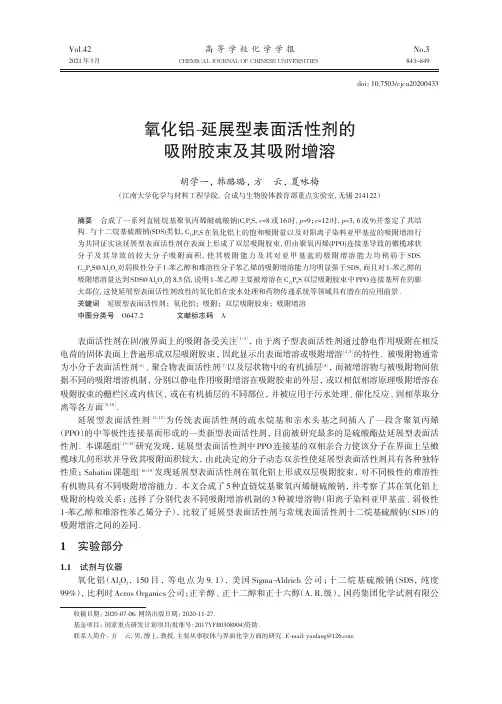
Vol.42 2021年3月No.3843~849 CHEMICAL JOURNAL OF CHINESE UNIVERSITIES高等学校化学学报氧化铝-延展型表面活性剂的吸附胶束及其吸附增溶胡学一,韩璐璐,方云,夏咏梅(江南大学化学与材料工程学院,合成与生物胶体教育部重点实验室,无锡214122)摘要合成了一系列直链烷基聚氧丙烯醚硫酸钠(Cc P p S,c=8或16时,p=9;c=12时,p=3,6或9)并鉴定了其结构.与十二烷基硫酸钠(SDS)类似,C12P9S在氧化铝上的饱和吸附量以及对阳离子染料亚甲基蓝的吸附增溶行为共同证实该延展型表面活性剂在表面上形成了双层吸附胶束,但由聚氧丙烯(PPO)连接基导致的橄榄球状分子及其导致的较大分子吸附面积,使其吸附能力及其对亚甲基蓝的吸附增溶能力均稍弱于SDS.C12P9S@Al2O3对弱极性分子1-苯乙醇和难溶性分子苯乙烯的吸附增溶能力均明显强于SDS,而且对1-苯乙醇的吸附增溶量达到SDS@Al2O3的8.5倍,说明1-苯乙醇主要被增溶在C12P9S双层吸附胶束中PPO连接基所在的膨大部位,这使延展型表面活性剂改性的氧化铝在废水处理和药物传递系统等领域具有潜在的应用前景.关键词延展型表面活性剂;氧化铝;吸附;双层吸附胶束;吸附增溶中图分类号O647.2文献标志码A表面活性剂在固/液界面上的吸附备受关注[1~3],由于离子型表面活性剂通过静电作用吸附在相反电荷的固体表面上普遍形成双层吸附胶束,因此显示出表面增溶或吸附增溶[4,5]的特性.被吸附物通常为小分子表面活性剂[6]、聚合物表面活性剂[7]以及层状物中的有机插层[8],而被增溶物与被吸附物间依据不同的吸附增溶机制,分别以静电作用吸附增溶在吸附胶束的外层,或以相似相溶原理吸附增溶在吸附胶束的栅栏区或内核区,或在有机插层的不同部位,并被应用于污水处理、催化反应、固相萃取分离等各方面[9,10].延展型表面活性剂[11,12]为传统表面活性剂的疏水烷基和亲水头基之间插入了一段含聚氧丙烯(PPO)的中等极性连接基而形成的一类新型表面活性剂,目前被研究最多的是硫酸酯盐延展型表面活性剂.本课题组[13~15]研究发现,延展型表面活性剂中PPO连接基的双相亲合力使该分子在界面上呈橄榄球几何形状并导致其吸附面积较大,由此决定的分子动态双亲性使延展型表面活性剂具有各种独特性质;Sabatini课题组[16~19]发现延展型表面活性剂在氧化铝上形成双层吸附胶束,对不同极性的难溶性有机物具有不同吸附增溶能力.本文合成了5种直链烷基聚氧丙烯醚硫酸钠,并考察了其在氧化铝上吸附的构效关系;选择了分别代表不同吸附增溶机制的3种被增溶物(阳离子染料亚甲基蓝、弱极性1-苯乙醇和难溶性苯乙烯分子),比较了延展型表面活性剂与常规表面活性剂十二烷基硫酸钠(SDS)的吸附增溶之间的差同.1实验部分1.1试剂与仪器氧化铝(Al2O3,150目,等电点为9.1),美国Sigma-Aldrich公司;十二烷基硫酸钠(SDS,纯度99%),比利时Acros Organics公司;正辛醇、正十二醇和正十六醇(A.R.级),国药集团化学试剂有限公doi:10.7503/cjcu20200433收稿日期:2020-07-06.网络出版日期:2020-11-27.基金项目:国家重点研发计划项目(批准号:2017YFB0308904)资助.联系人简介:方云,男,博士,教授,主要从事胶体与界面化学方面的研究.E-mail:***************Vol.42高等学校化学学报司;苯乙烯(ST ,纯度99%),上海阿拉丁生化科技股份有限公司;亚甲基蓝(MB ,纯度95%)和1-苯乙醇(PA ,纯度98%),上海泰坦科技有限公司.Nicolet 6700型傅里叶变换全反射红外光谱仪(FTIR ),美国Thermo Fisher 有限公司;Avance III HD 400MHz 型核磁共振波谱仪(1H NMR ),瑞士Bruker 公司;SHZ -82型水浴恒温振荡器,金坛市医疗仪器厂;TU -1950型紫外分光光度计,北京普析通用仪器有限责任公司;1100SF 型热重分析仪,瑞士Mettler Toledo 公司.1.2实验方法1.2.1合成和结构鉴定参考文献[14]方法制备C c P p ,然后合成一系列直链烷基聚氧丙烯醚硫酸钠(C c P p S ,c =8或16时,p =9;c =12时,p =3,6或9),合成路线见Scheme 1.以C 12P 9S 为例,取10g 的C 12P 9和等质量的1,2-二氯乙烷放于带有尾气吸收装置的三口烧瓶中,在冰水浴和机械搅拌下缓慢滴加1.84g 氯磺酸;滴加完毕用0.5mol/L 的氢氧化钠乙醇溶液中和产物至pH=8左右,离心除去无机盐;加入无水硫酸钠静置一段时间后离心除去,蒸发除去乙醇溶剂,再经柱层析得到目标产物C 12P 9S ,通过FTIR 和1H NMR 对C c P p S 的结构进行表征.1.2.2表面活性剂溶液浓度的测定当水溶液中表面活性剂浓度低于1mmol/L 时,采用亚甲基蓝氯仿萃取分光光度法测定[20]:配制一系列不同浓度表面活性剂溶液,移取10mL 已知浓度的表面活性剂溶液、1mL 1mmol/L 的亚甲基蓝溶液及5mL 氯仿放入样品瓶中,充分摇动1min ,静置待分层;取氯仿层进行紫外吸收(653nm )检测并绘制标准曲线,据此确定经氧化铝吸附后溶液中表面活性剂的残余浓度c e (mmol/L).当水溶液中表面活性剂浓度高于1mmol/L 时,采用混合指示剂两相滴定法进行测定[21]:分别移取25mL 待测溶液、15mL 氯仿、10mL 酸性混合指示剂及10mL 去离子水放入100mL 带有塞子的量筒中,充分震荡混合均匀;用已知浓度的海明1622标准溶液滴定,按照下式计算溶液中表面活性剂的残余浓度:c e =c Hyamine ×ΔV 25(1)式中:c Hyamine (mmol/L )为海明1622标准溶液的浓度;ΔV (mL )为消耗海明1622的体积;c e (mmol/L )为溶液中表面活性剂的残余浓度.1.2.3氧化铝上表面活性剂吸附量的测定典型的吸附实验如下:精确称取100mg 氧化铝并放入250mL 磨口锥形瓶中,将不同体积已知浓度表面活性剂溶液移入瓶中,调整体系pH 为7,在25℃下恒温振荡24h 后离心分离10min ;测量上清液中表面活性剂的残余浓度,根据下式计算氧化铝上表面活性剂的吸附量[22]:q e =()c 0-c e V m(2)式中:c 0(mmol/L)为表面活性剂溶液的浓度;V (100mL )为表面活性剂溶液的体积;m (mg )为氧化铝的质量(mg );q e (mmol/g)为氧化铝上表面活性剂的吸附量.在上述实验过程中改变振荡时间优化吸附平衡时间;改变NaCl 浓度优化盐浓度;改变C c P p S 的p 值或c 值考察对氧化铝上表面活性剂吸附量的影响.1.2.4热重法测定氧化铝上表面活性剂的吸附量经离心获得的改性氧化铝SDS@Al 2O 3和C 12P 9S@Al 2O 3固体(制备条件为:表面活性剂浓度为4mmol/L ,100mg 氧化铝,固/液质量比1∶1000,24h ,t =25℃,c NaCl =1mmol/L ,pH=7),于110℃下干燥恒重后采用热重分析仪测定:将样品置于瓷坩锅Scheme 1Synthetic route of C c P p S844No.3胡学一等:氧化铝-延展型表面活性剂的吸附胶束及其吸附增溶中,氧气流速25mL/min ,升温速率为20℃/min ,测试温度范围50~650℃;将失重率(质量分数)除以表面活性剂分子量得到氧化铝上表面活性剂吸附量Γ(mmol/g ).1.2.5吸附增溶实验精确称取100mg 的SDS@Al 2O 3或C 12P 9S@Al 2O 3并分别放入装有100mL 0.2mmol/L 亚甲基蓝(或8.19mmol/L 的1-苯乙醇或0.96mmol/L 的苯乙烯)水溶液的三角瓶中,在25℃恒温水浴振荡器中振荡24h ,完成吸附增溶过程;离心后取上层清液测定λMB =666nm (或λPA =205nm 或λST =253nm )的紫外吸光度,以确定体系中剩余亚甲基蓝(或苯乙醇或苯乙烯)的浓度c (mmol/L ),按照下式计算改性氧化铝的吸附增溶量:Γ=()c 0-c V ×10-3m ×q e (3)式中:c 0(mmol/L)为甲基蓝(或苯乙醇或苯乙烯)的初始浓度;c (mmol/L )为上层清液中剩余甲基蓝(或苯乙醇或苯乙烯)的浓度;V (100mL )为甲基蓝(或苯乙醇或苯乙烯)溶液的体积;Γ(mmol 被增溶物/mol 表面活性剂)为改性氧化铝的增溶量.2结果与讨论2.1C c P p S 的结构表征C c P p S 的结构表征结果如下.以C 12P 9S 为例,FTIR 中1242cm ‒1处的峰归属为C —O —S 的伸缩振动,781cm ‒1处的峰归属为S =O 的伸缩振动,说明C 12P 9与ClSO 3H 发生硫酸酯化反应合成了C 12P 9S ;1H NMR 中以CH 3在化学位移为δ0.90处积分值是3为基准,δ3.30~4.01处积分值是28,进一步说明C 12P 9S 的聚氧丙烯平均加成数p 为9.C 8P 9S 的表征数据:FTIR ,ν/cm ‒1:1252(C —O —S ),1108(C —O —C ),787(S =O );1H NMR (CDCl 3),δ:0.83(t ,3H ,CH 3),1.05~1.50(m ,39H ),3.06~4.21(m ,28H ),4.68(m ,1H ,CH ).C 12P 3S 的表征数据:FTIR ,ν/cm ‒1:1252(C —O —S ),1108(C —O —C ),787(S =O );1H NMR (CDCl 3),δ:0.90(t ,3H ,CH 3),1.10~1.42(m ,29H ),3.23~3.86(m ,10H ),4.74(m ,1H ,CH ).C 12P 6S 的表征数据:FTIR ,ν/cm ‒1:1252(C —O —S ),1107(C —O —C ),787(S =O );1H NMR (CDCl 3),δ:0.90(t ,3H ,CH 3),1.10~1.57(m ,38H ),3.06~4.21(m ,19H ),4.78(m ,1H ,CH ).C 12P 9S 的表征数据:FTIR ,ν/cm ‒1:1242(C —O —S ),1106(C —O —C ),781(S =O );1H NMR (CDCl 3),δ:0.89(t ,3H ,CH 3),1.10~1.57(m ,47H ),3.30~4.01(m ,28H ),4.70(m ,1H ,CH ).C 16P 9S 的表征数据:FTIR ,ν/cm ‒1:1254(C —O —S ),1110(C —O —C ),784(S =O );1H NMR (CDCl 3),δ:0.89(t ,3H ,CH 3),1.11~1.57(m ,55H ),3.26~4.05(m ,28H ),4.63(m ,1H ,CH ).2.2氧化铝上C c P p S 的吸附等温线及其双层吸附胶束各种表面活性剂与亚甲基蓝络合物的标准曲线的线性回归方程见表1,据此测得的氧化铝上C 12P 9S 吸附的时间进程见图1(A ),24h 后基本达到吸附平衡,因此以下实验的吸附时间确定为24h.推测图1(A )中开始阶段的快吸附缘于C 12P 9S 的硫酸头基被静电吸引而快速吸附在荷正电的氧化铝表面,后期慢吸附可能相应于借助疏水作用完成双层吸附胶束的外层.文献[17]报道氧化铝上SDS 形成双层吸附胶束,且饱和吸附量为0.38mmol/g ;图1(B )中吸附等温线得到C 12P 9S 的饱和吸附量为0.37mmol/g ,由于两者的吸附作用机制均为静电吸引,初步证实氧化铝上C 12P 9S 也形成双层吸附胶束;另一方面根据Table 1Linear regression equation of calibration curves of C c P p S -MB complex in chloroformSurfactant C 12P 3S C 12P 6S C 12P 9S C 8P 9S C 16P 9S SDS Linear regression equation y =0.166x +0.1050y =0.171x +0.1115y =0.204x +0.06197y =0.194x +0.06848y =0.120x +0.1426y =0.202x +0.1415R 20.9980.9990.9970.9970.9980.999845Vol.42高等学校化学学报氧化铝的比表面积为155m 2/g [17]计算得到C 12P 9S 的吸附分子截面积为0.70nm 2,由比表面张力法测得C 12P 9S 在气/液界面饱和吸附单层的分子面积1.75nm 2[14]的一半略低,因此进一步支持氧化铝上C 12P 9S 形成双层吸附胶束.将图1(B )的数据按照下面Langmuir 和Freundlich 吸附等温式分别回归,回归曲线见图2,拟合方程见式(6)和式(7).c e q e =1q m K L +c e q m(4)式中:c e (mmol/L)为吸附平衡浓度;q e (mmol/g )为平衡吸附量;q m (mmol/g )为吸附剂被铺满一双分子层的吸附质的吸附量;K L 为Langmuir 吸附常数.ln q e =ln K F +1nln c e (5)式中:K F 为Freundlich 吸附常数;n 为吸附层数.c e q e =10.3726×3.2693+c e 0.3726,R 2=0.998(6)ln q e =-1.2208+13.78ln c e ,R 2=0.926(7)从图2(A )和式(6)发现,Langmuir 吸附方程的拟合相关度(R 2)达到了0.998,因此可以确定其吸附模型为Langmuir 型[23].由图3(A )可知,NaCl 的加入使得氧化铝上表面活性剂吸附量略有增加,这是因为其PPO 链具有盐压迫性[24].由图3(B )可知,随着PPO 连接基增长吸附量减少,这是因为氧化铝上延展型表面活性剂吸附面积变大;而图3(C )可知,随着碳链增长吸附量增加,这是因为疏水相互作用增大.Fig.1Adsorption equilibrium time(A)and adsorption isotherm(B)of C 12P 9S on aluminapH=7at 25℃for 24h withoutNaCl.Fig.2Fitting equations of Langmuir(A)and Freundlich(B)for C 12P 9S adsorption on alumina846No.3胡学一等:氧化铝-延展型表面活性剂的吸附胶束及其吸附增溶2.3氧化铝上表面活性剂的吸附量由图4的热重曲线得出SDS@Al 2O 3的失重率为7.1%,C 12P 9S@Al 2O 3的失重率为14.5%.与SDS@Al 2O 3的热重曲线对比可知,C 12P 9S 在200℃后的失重曲线的斜率变陡缘于PPO 链在该温度下易断裂分解.根据失重率计算得到SDS@Al 2O 3的表面活性剂吸附量为0.267mmol (SDS )/g (Al 2O 3),C 12P 9S@Al 2O 3的表面活性剂吸附量为0.209mmol (C 12P 9S )/g (Al 2O 3),显然SDS 的摩尔吸附量略高于C 12P 9S ,这与图3(B )中PPO 连接基越短吸附量越大的规律一致.2.4吸附增溶结果及比较依据亚甲基蓝水溶液标准曲线(y =61.79x +0.006,R 2=0.999)、1-苯乙醇水溶液标准曲线(y =8.203x +0.005,R 2=0.999)、苯乙烯水溶液标准曲线(y=5.418x ‒0.003,R 2=0.999)以及热重法获得的氧化铝上表面活性剂吸附量,测得吸附增溶结果见表2.由表2中吸附增溶量的实验数据可知,C 12P 9S@Al 2O 3对亚甲基蓝的吸附增溶量约为SDS@Al 2O 3的2/3,这与氧化铝上C 12P 9S 的吸附量只是SDS 的4/5趋势相同,均为C 12P 9S 橄榄球形分子的吸附面积较大所致;由于亚甲基蓝只吸附增溶在吸附胶束的外层,如Scheme 2(A )所示,因此上述结果也支持C 12P 9S在氧化铝上形成双层吸附胶束的结论.根据相似相溶原理,苯乙烯主要增溶在吸附胶束的疏水栅栏和内核,但C 12P 9S 对其吸附增溶能力为SDS 的1.8倍的结果说明,C 12P 9的双层吸附胶束的PPO 连接基部位对增溶苯乙烯作出接近于疏水栅栏和内核的贡献,如Scheme 2(B )所示.由于1-苯乙醇的水溶性较大因而在水中较为安定,SDS 吸附胶束对其的增溶量很小,甚至只能达到亚甲基蓝的2/3左右,但C 12P 9对其的吸附增溶量却比SDS 大7.5倍,如Scheme 2(C )所示,这应该全部归结为双层吸附胶束的PPO 连接基部位的特殊增溶贡献.C 12P 9的PPO 连接基对吸附增溶弱极性分子1-苯乙醇的贡献是吸附增溶苯乙烯的1.4倍,说明PPO 连接基与1-苯乙醇的相似相溶性使其增溶效率超过苯乙烯,且高达其分子中疏水基(或等同于SDS 分子)增溶1-苯乙醇能力的8.5倍,这也从另一个角度证实了PPO 链的双相亲合力[13~15].以上实验结果表明,与常规表面活性剂相比,延展型表面活性剂独特的PPO 连接基结构不仅可以明显增大对难溶性物质的吸附增溶效果,而且可以使吸附增溶水溶性较好的极性分子成为可能.Fig.3Effects of NaCl(A),PPO(B)and hydrocarbon chain length(C)on adsorption capacitiespH=7at 25℃for 24h.Table 2Adsolubilization of MB,PA and ST by SDS@Al 2O 3,C 12P 9S@Al 2O 3and Al 2O 3Absorbent SDS@Al 2O 3C 12P 9S@Al 2O 3Al 2O 3ΓMB /(mmol·mol -1)380220ca .0ΓST /(mmol·mol -1)17003020ca .0ΓPA /(mmol·mol -1)2402030ca .0Fig.4TGA curves of SDS@Al 2O 3and C 12P 9S@Al 2O 3847Vol.42高等学校化学学报氧化铝是水污染处理中常用的吸附剂,由于氧化铝上延展型表面活性剂的吸附胶束可以同时高效率增溶像苯乙烯这样的难溶性分子和1-苯乙醇这样的极性有机污染物,因此在水污染处理中显示很大的应用前景.由于药物也有疏水性和亲水性之分,因此其同样具有在药物传递系统中的应用潜能.3结论本文合成并鉴定了一系列硫酸酯盐延展型表面活性剂C c P p S ,与SDS 比较了在氧化铝上的吸附胶束及其吸附增溶,证明与SDS 类似其在氧化铝上形成Langmuir 型的双层吸附胶束.加入NaCl 以及增长C c P p S 的碳链均有利于吸附,但延长PPO 链却对其不利.对于通过静电作用机制吸附增溶的阳离子染料亚甲基蓝而言,PPO 连接基导致的橄榄球分子形状使其吸附增溶能力弱于SDS ;但对于弱极性1-苯乙醇和难溶性苯乙烯分子,C 12P 9S@Al 2O 3的吸附增溶能力则明显强于SDS.C 12P 9S@Al 2O 3对苯乙烯的吸附增溶量接近SDS@Al 2O 3的2倍,对1-苯乙醇的吸附增溶量是SDS@Al 2O 3的8.5倍.以上实验结果表明,延展型表面活性剂独特的PPO 连接基结构不仅可以明显增大对难溶性分子的吸附增溶效果,而且可以使水溶性较好的极性分子的吸附增溶成为可能.因此延展型表面活性剂改性的氧化铝显示出应用于去除污水中的难溶性或水溶性有机物的广阔前景,同时具有在药物传递系统中的应用潜能.参考文献[1]Paria S.,Khilar K.C.,Adv.Colloid Interface Sci.,2004,110(3),75—95[2]Du Y.F.,Ai C.Q.,Zhang Y.Y.,Wang W.,Chem.J.Chinese Universities ,2019,40(9),770—774(杜毅帆,艾超前,张瑶瑶,王伟.高等学校化学学报,2019,40(9),770—774)[3]Zhang X.,Zhang T.C.,Jiang P.,Ge J.J.,Zhang G.C.,Chem.J.Chinese Universities ,2020,41(5),1076—1084(张旋,张天赐,蒋平,葛际江,张贵才.高等学校化学学报,2020,41(5),1076—1082)[4]Sharma R.,Surfactant Adsorption and Surface Solubilization ,ACS Symposium Series V615,American Chemical Society :Washington ,DC ,1996[5]Pal M.U.,Recent Pat.Eng.,2013,7(3),167—181[6]Zhang P.,Lo I.,O'connor D.,Pehkonen S.,Cheng H.F.,Hou D.Y.,J.Colloid Interface Sci.,2017,508,39—48[7]Attaphong C.,Asnachinda E.,Charoensaeng A.,Sabatini D.A.,Khaodhiar S.,J.Colloid Interface Sci.,2010,344(1),126—131[8]Zhao P.W.,Liu X.H.,Tian W.L.,Yan D.P.,Sun X.M.,Lei X.D.,Chem.Eng.J.,2015,279,597—604[9]Pal P.,Pal A.,J.Mol.Liq.,2017,248,713—724[10]Mahamallik P.,Pal A.,Catal.Today ,2019,348,212—222[11]Chlebicki J.,Tenside ,Surfactants ,Deterg .,1990,27(6),413—416[12]Attaphong C.,Do L.,Sabatini D.A.,Fuel ,2012,94,606—613[13]Chen J.,Hu X.Y.,Fang Y.,Jin G.Y.,Xia Y.M.,J.Colloid Interface Sci.,2019,547,190—198[14]Chen J.,Hu X.Y.,Fang Y.,Liu H.H.,Xia Y.M.,Langmuir ,2019,35(8),3116—3125[15]Chen J.,Hu X.Y.,Fang Y.,Xia Y.M.,J.Mol.Liq.,2020,311,113276[16]Charoensaeng A.,Sabatini D.A.,Khaodhiar S.,J.Surfactants Deterg.,2009,12(3),209—217[17]Charoensaeng A.,Sabatini D.A.,Khaodhiar S.,J.Surfactants Deterg.,2008,11(1),61—71Scheme 2Schematic illustration and comparison of adsolubilization capacities(Γ)of MB,ST and PA848No.3胡学一等:氧化铝-延展型表面活性剂的吸附胶束及其吸附增溶[18]Arpornpong N.,Charoensaeng A.,Sabatini D.A.,Khaodhiar S.,J.Surfactants Deterg.,2010,13(3),305—311[19]Arpornpong N.,Lewlomphaisan J.,Charoensaeng A.,Sabatini D.A.,Khaodhiar S.,J.Surfactants Deterg.,2013,16(3),291—298[20]Koga M.,Anal.Sci.,1999,15(6),563—568[21]Li Z.P.,Rosen M.J.,Anal.Chem.,1981,53(9),1516—1519[22]Wang L.C.,Ni X.J.,Cao Y.H.,Appl.Surf.Sci.,2018,428,165—170[23]Salari Z.A.,Kharrat R.,Aust.J.Basic Appl.Sci.,2011,5(12),808—813[24]He W.D.,Ge J.J.,Zhang G.C.,Jiang P.,Jin L.,ACS Omega ,2019,4,12410—12417Admicelles and Adsolubilization of Extended Surfactants on Alumina †HU Xueyi ,HAN Lulu ,FANG Yun *,XIA Yongmei(Key Laboratory of Synthetic and Biological Colloids ,Ministry of Education ,School of Chemical and MaterialEngineering ,Jiangnan University ,Wuxi 214122,China )AbstractA series of sodium linear alkyl polyoxypropylene ether sulfates (C c P p S ,c =8or 16,p =9;c =12,p =3,6or 9)was synthesized and structurally identified to investigate the formation of admicelles of extended surfactants on alumina and the related adsolubilization.The formation of bilayer admicelles of C 12P 9S on alumi⁃na was identified by the adsolubilization result of cationic dye methylence blue (MB )in comparison with sodium dodecyl ether sulfate (SDS ),but the adsorption capacity of C 12P 9S and adsolubilization capacity of MB were both less than SDS for its rugby -shaped molecule caused by polyoxypropylene (PPO )spacer.On the con⁃trary ,C 12P 9S@Al 2O 3showed stronger adsolubilization capacities of weak polar PA molecules and water -insolu⁃ble ST molecules than those of SDS evidently.Moreover ,the adsolubilization capacity of PA by C 12P 9S@Al 2O 3was 8.5times of SDS@Al 2O 3,which means that PA molecules were adsolubilized as expected in the swollenPPO domains in bilayer admicelles of C 12P 9S on alumina ,and makes extended surfactant modified alumina po⁃tential application prospects in some fields such as wastewater treatment and drug delivery systems.Keywords Extended surfactant ;Alumina ;Adsorption ;Bilayer admicelle ;Adsolubilization (Ed.:V ,K ,S)and Development Program of China (No.2017YFB0308904).849。
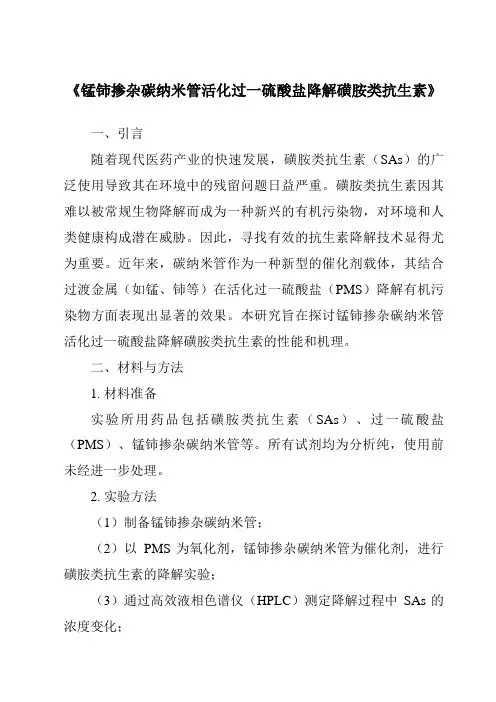
《锰铈掺杂碳纳米管活化过一硫酸盐降解磺胺类抗生素》一、引言随着现代医药产业的快速发展,磺胺类抗生素(SAs)的广泛使用导致其在环境中的残留问题日益严重。
磺胺类抗生素因其难以被常规生物降解而成为一种新兴的有机污染物,对环境和人类健康构成潜在威胁。
因此,寻找有效的抗生素降解技术显得尤为重要。
近年来,碳纳米管作为一种新型的催化剂载体,其结合过渡金属(如锰、铈等)在活化过一硫酸盐(PMS)降解有机污染物方面表现出显著的效果。
本研究旨在探讨锰铈掺杂碳纳米管活化过一硫酸盐降解磺胺类抗生素的性能和机理。
二、材料与方法1. 材料准备实验所用药品包括磺胺类抗生素(SAs)、过一硫酸盐(PMS)、锰铈掺杂碳纳米管等。
所有试剂均为分析纯,使用前未经进一步处理。
2. 实验方法(1)制备锰铈掺杂碳纳米管;(2)以PMS为氧化剂,锰铈掺杂碳纳米管为催化剂,进行磺胺类抗生素的降解实验;(3)通过高效液相色谱仪(HPLC)测定降解过程中SAs的浓度变化;(4)分析降解产物的种类及毒性;(5)探讨降解机理。
三、结果与讨论1. 降解效果实验结果显示,锰铈掺杂碳纳米管活化过一硫酸盐对磺胺类抗生素的降解效果显著。
在一定的反应条件下,SAs的降解率随反应时间的延长而增加。
同时,锰铈掺杂碳纳米管的催化活性在多次循环使用后仍能保持较高的水平。
2. 降解产物及毒性分析通过HPLC分析,我们发现磺胺类抗生素在降解过程中产生了多种中间产物。
这些中间产物的毒性与原始SAs相比有所降低,表明降解过程有助于降低SAs的毒性。
然而,仍需进一步研究这些中间产物的环境行为及生态风险。
3. 降解机理探讨锰铈掺杂碳纳米管活化过一硫酸盐降解磺胺类抗生素的机理主要包括两个方面:一是碳纳米管和过渡金属的催化作用,能够有效地活化PMS产生具有强氧化性的自由基;二是自由基与SAs 分子之间的反应,导致SAs分子的断裂和降解。
此外,锰、铈元素的存在也有助于提高催化剂的活性和稳定性。
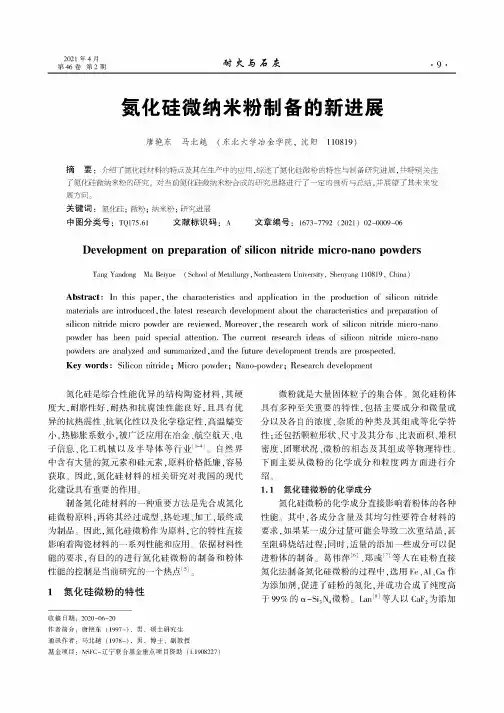
第46卷第2期氮化硅微纳米粉制备的新进展唐艳东马北越(东北大学冶金学院,沈阳110819)摘要:介绍了氮化硅材料的特点及其在生产中的应用,综述了氮化硅微粉的特性与制备研究进展,并特别关注了氮化硅微纳米粉的研究。
对当前氮化硅微纳米粉合成的研究思路进行了一定的剖析与总结,并展望了其未来发展方向。
关键词:氮化硅;微粉;纳米粉;研究进展中图分类号:TQ175.61文献标识码:A文章编号:1673-7792(2021)02-0009-06 Development on preparation of silicon nitride micro-nano powders Tang Yandong Ma Beiyue(School of Metallurgy,Northeastem University袁Shenyang110819袁China)Abstract:In t his paper,the characteristics and application in the production of silicon nitride materials are introduced袁the latest research development about the characteristics and preparation of silicon nitride micro powder are reviewed.Moreover袁the research work of silicon nitride micro-nano powder has been paid special attention.The current research ideas of silicon nitride micro-nano powders are analyzed and summarized袁and the future development trends are prospected.Key words:Silicon nitride;Micro powder;Nano-powder;Research development氮化硅是综合性能优异的结构陶瓷材料,其硬度大,耐磨性好,耐热和抗腐蚀性能良好,且具有优异的抗热震性、抗氧化性以及化学稳定性,高温蠕变小,热膨胀系数小,被广泛应用在冶金、航空航天、电子信息、化工机械以及半导体等行业[|-4]遥自然界中含有大量的氮元素和硅元素,原料价格低廉,容易获取。
第34卷第1期2021年2月Vol.34No.1Feb.2021投稿网址: 石油化工高等学校学报JOURNAL OF PETROCHEMICAL UNIVERSITIESV2O5/g⁃C3N4催化剂的制备及其模拟油中硫化物的脱除张豪,李秀萍,赵荣祥(辽宁石油化工大学石油化工学院,辽宁抚顺113001)摘要:以三聚氰胺、偏钒酸铵、硼酸为前驱体,通过煅烧法制备V2O5/g⁃C3N4催化剂。
采用XRD、FT⁃IR、XPS、SEM和BET等技术对催化剂的结构与形貌进行表征。
以V2O5/g⁃C3N4为催化剂,乙腈为萃取剂,H2O2为氧化剂对模拟油中二苯并噻吩(DBT)的脱除进行考察。
探究了反应温度、催化剂质量、萃取剂体积、n(H2O2)/n(S)以及不同硫化物等因素对脱硫效果的影响。
在模拟油体积为5.0mL、萃取剂乙腈体积为3.0mL、n(H2O2)/n(S)=8、催化剂质量为0.02g、反应温度为30℃和反应时间为60min的最佳条件下,DBT的脱除率达到91.9%,经过5次催化剂再生后脱硫率仍可以达到85.7%。
关键词:V2O5/g⁃C3N4;氧化脱硫;二苯并噻吩;三聚氰胺中图分类号:TE624文献标志码:A doi:10.3969/j.issn.1006⁃396X.2021.01.002Preparation of V2O5/g⁃C3N4Catalyst and Desulfurization Ability in Model OilZhang Hao,Li Xiuping,Zhao Rongxiang(School of Petrochemical Engineering,Liaoning Petrochemical University,Fushun Liaoning113001,China)Abstract:The V2O5/g⁃C3N4catalyst was prepared by calcination method,using melamine,ammonium metavanadate,boric acid as precursors and methanol as solvent.The structure and morphology of the catalyst were characterized by X⁃Ray Diffraction(XRD), Fourier transform infrared spectroscopy(FT⁃IR),X⁃ray photoelectron spectroscopy(XPS),scanning tunneling microscope(SEM) and brunauer⁃emmett⁃teller(BET).The desulfurization ability of dibenzothiophene(DBT)in model oil was investigated using V2O5/g⁃C3N4as catalyst,acetonitrile as extractant and H2O2as oxidant.The effects of reaction temperature,amount of catalyst and extractant,n(H2O2)/n(S)molar ratio,and different sulfides on desulfurization rate were investigated.Under the optimum conditions: 5.0mL model oil,3.0mL acetonitrile,n(H2O2)/n(DBT)=8,0.02g of catalyst,temperature was30℃and reaction time was60min, the desulfurization rate of DBT can reach91.9%,which can also keep at a higher value at85.7%after5times of catalyst regeneration. Keywords:V2O5/g⁃C3N4;Oxidative desulfurization;Dibenzothiophene(DBT);Melamine随着汽车工业的迅速发展,燃料油燃烧产生的硫化物对环境的污染越来越严重[1⁃2]。
农 药AGROCHEMICALS 第49卷第3期2010年3月Vol. 49, No. 3Mar. 2010氯虫苯甲酰胺的合成王艳军,张大永,吴晓明(中国药科大学 药学院, 南京 210009)摘要:以顺丁烯二酸酐、2,3-二氯吡啶为起始原料经8步反应合成中间体3-溴-1-(3-氯吡啶-2-吡啶基)-1H -吡唑-5-甲酸(9);以2-氨基-3-甲基苯甲酸为原料经1步反应合成中间体5-氯-2-氨基-3-甲基苯甲酸(10)。
中间体9与10反应生成氯虫苯甲酰胺。
目标化合物经1H NMR 确证。
反应总收率36.3%(以2,3-二氯吡啶计),产品含量(HPLC)不小于95%。
关键词:氯虫苯甲酰胺;杀虫剂;合成中图分类号:TQ460.3 文献标志码:A 文章编号:1006-0413(2010)03-0170-04Synthesis of ChlorantraniliproleWANG Yan-jun, ZHANG Da-yong, WU Xiao-ming(School of Pharmacy, China Pharmaceutical University, Nanjing 210009, China)Abstract: Chlorantraniliprole was synthesized by reaction of 3-bromo-1-(3-chloropyridin- 2-pyridinyl)-1H -pyrazole-5-carboxylic acid with 2-amino-5-chloro-3-methylbenzoic acid.3-bromo-1-(3-chloropyridin-2-pyridinyl)-1H -pyrazole-5-carboxylic acid was prepared by reaction of maleic anhydride with 2,3-dichloropyridine as starting materials in eight steps. 2-Amino-5-chloro-3-methylbenzoic acid was prepared by reaction of 2-amino-3-methylbenzoic acid in one step. The structure of target compound was con fi rmed by 1H NMR. Total yield was 36.3%(calculated with 2,3-dichloropyridine), and purity determined by HPLC was over 95%.Key words: chlorantraniliprole; insecticide; synthesis氯虫苯甲酰胺(chlorantraniliprole ,商品名Aliaco 、Coragen 、Rynaxypyr)实验代号DPX -E2Y45,是美国杜邦公司2000年开发的一类新型高效、低毒的邻甲酰氨基苯甲酰胺类杀虫剂,对鳞翅目昆虫有特效[1]。
基金项目:陕西省科技厅重点项目(编号:2019NY 194);陕西省西安市未央区科技计划项目(编号:202038);陕西省重点研发计划项目(编号:2021NY 124)作者简介:李慧(1976—),女,陕西科技大学副教授,硕士生导师,博士。
E mail:lihui@sust.edu.cn收稿日期:2022 07 24 改回日期:2023 02 10犇犗犐:10.13652/犼.狊狆犼狓.1003.5788.2022.80585[文章编号]1003 5788(2023)04 0103 07聚乙烯醇/纳米纤维素/石榴皮多酚复合抗菌薄膜性能研究Studyonpropertiesofpolyvinylalcohol/nanocellulose/pomegranatepeelpolyphenolcompositeantibacterialfilms李 慧1犔犐犎狌犻1 田家瑶1犜犐犃犖犑犻犪 狔犪狅1 庞姗姗1犘犃犖犌犛犺犪狀 狊犺犪狀1 龚国利2犌犗犖犌犌狌狅 犾犻2(1.陕西科技大学设计与艺术学院,陕西西安 710021;2.陕西科技大学食品与生物工程学院,陕西西安 710021)(1.犛犮犺狅狅犾狅犳犃狉狋犪狀犱犇犲狊犻犵狀,犛犺犪犪狀狓犻犝狀犻狏犲狉狊犻狋狔狅犳犛犮犻犲狀犮犲牔犜犲犮犺狀狅犾狅犵狔,犡犻 犪狀,犛犺犪犪狀狓犻710021,犆犺犻狀犪;2.犛犮犺狅狅犾狅犳犉狅狅犱犪狀犱犅犻狅犲狀犵犻狀犲犲狉犻狀犵,犛犺犪犪狀狓犻犝狀犻狏犲狉狊犻狋狔狅犳犛犮犻犲狀犮犲牔犜犲犮犺狀狅犾狅犵狔,犡犻 犪狀,犛犺犪犪狀狓犻710021,犆犺犻狀犪)摘要:目的:开发绿色抗菌抗氧化食品包装薄膜。
方法:以石榴皮多酚为功能活性物质,采用共混法制备聚乙烯醇/纳米纤维素晶体/石榴皮多酚复合抗菌薄膜,并对其性能进行表征。
结果:石榴皮多酚的添加影响了薄膜表面的连续性;当石榴皮多酚添加量为5倍最小抑菌浓度时,薄膜的透水气性增加了28.79%,拉伸强度、断裂伸长率、疏水性及透光率分别降低了44.97%,29.37%,36.36%,22.35%,同时总酚含量为(5.92±0.17)mg/L,DPPH自由基清除率达到(13.31±0.22)%;薄膜表现出良好的抑菌性,对白色念珠菌的抑菌效果最好,其次为金黄色葡萄球菌、大肠杆菌。
《乳酸菌胞外多糖-氧化石墨烯纳米佐剂的构建及免疫效果研究》篇一一、引言随着生物技术的不断进步,纳米技术在医药领域的应用日益广泛。
其中,乳酸菌胞外多糖(EPS)和氧化石墨烯(GO)因其独特的物理化学性质和生物相容性,在药物传递、生物成像和免疫调节等方面展现出了重要的应用潜力。
近年来,两者的复合物—乳酸菌胞外多糖-氧化石墨烯纳米佐剂,逐渐成为了免疫疗法的研究热点。
本论文着重对乳酸菌胞外多糖-氧化石墨烯纳米佐剂的构建及其免疫效果进行研究。
二、材料与方法1. 材料本实验所需材料包括乳酸菌胞外多糖、氧化石墨烯、生物相容性良好的溶剂等。
所有材料均经过严格筛选和纯化处理。
2. 方法(1)乳酸菌胞外多糖-氧化石墨烯纳米佐剂的构建首先,将乳酸菌胞外多糖与氧化石墨烯进行复合,通过物理或化学方法,制备出稳定的纳米佐剂。
接着,对纳米佐剂的粒径、电位等基本性质进行表征。
(2)免疫效果研究将构建的纳米佐剂用于动物模型中,通过注射或口服等方式给予,观察其对机体的免疫调节作用。
采用流式细胞术、ELISA 等方法检测机体的免疫反应指标,如抗体滴度、细胞因子水平等。
三、结果与讨论1. 乳酸菌胞外多糖-氧化石墨烯纳米佐剂的构建通过物理或化学方法,成功构建了乳酸菌胞外多糖-氧化石墨烯纳米佐剂。
该纳米佐剂具有较小的粒径、良好的稳定性和分散性,且电位适中,有利于其在生物体内的传递和分布。
此外,该纳米佐剂在紫外-可见光谱、动态光散射等表征手段下表现出良好的性质。
2. 免疫效果研究(1)抗体滴度分析通过给动物模型注射或口服乳酸菌胞外多糖-氧化石墨烯纳米佐剂,我们发现,与对照组相比,实验组动物的抗体滴度明显升高。
这表明该纳米佐剂具有良好的免疫增强作用,能够刺激机体产生更多的抗体。
(2)细胞因子水平分析通过ELISA等方法检测机体的细胞因子水平,我们发现,实验组动物的细胞因子水平在给予纳米佐剂后显著升高。
这表明该纳米佐剂能够激活机体的免疫系统,促进细胞因子的分泌。
CHEMICAL INDUSTRY AND ENGINEERING PROGRESS 2017年第36卷第12期·4524·化 工 进展石墨烯掺杂聚砜基正渗透膜的结构和性能胡念,左浩然,付佳蓓,吕慧,童奕皓,刘慧清,曹贵平(华东理工大学化学工程联合国家重点实验室,上海 200237)摘要:采用相转化法分别制备了掺杂有石墨、石墨烯和氧化石墨烯的聚砜正渗透(FO )膜支撑层,通过间苯二胺和均苯三甲酰氯间的界面聚合在支撑层表面制备了聚酰胺活性层。
采用扫描电子显微镜(SEM )表征膜表面和断面的结构形貌,测定膜孔隙率和亲水性,考察不同掺杂物时FO 膜的性能。
结果表明,掺杂石墨烯和氧化石墨烯,支撑层断面结构更加疏松,孔隙率和纯水透过常数(PWP )明显增加,制备的相应FO 膜性能得到改善,水通量增大。
掺杂石墨则导致支撑层上表面变粗糙,断面结构密实,其孔隙率减小,PWP 值降低,膜性能变差。
其中,掺杂了氧化石墨烯的FO 膜表现出最好的性能,水通量在活性层朝向驱动液侧(AL-DS )模式下可达37.10L/(m 2⋅h),相比无掺杂FO 膜增加了38.7%。
关键词:氧化石墨烯;掺杂;正渗透;膜;结构;性能中图分类号:TQ028.8 文献标志码:A 文章编号:1000–6613(2017)12–4524–09 DOI :10.16085/j.issn.1000-6613.2017-0475Structure and performance of forward osmosis membranes based on polysulfone substrates incorporated with grapheneHU Nian ,ZUO Haoran ,FU Jiabei ,LÜ Hui ,TONG Yihao ,LIU Huiqing ,CAO Guiping(State Key Laboratory of Chemical Engineering ,East China University of Science and Technology ,Shanghai 200237,China )Abstract :Polysulfone supporting layers incorporated with graphite (GI ),graphene (GE ),and graphene oxide (GO )were respectively prepared by phase inversion method. Then the polyamide active layers were prepared via interfacial polymerization of m -phenylenediamine and trimesoyl chloride on the supporting layers. The morphologies of top surface and cross section of the membranes were characterized by SEM. The porosity ,hydrophilicity and performance of FO membranes with different incorporated additives were investigated. The results showed that the structures of the cross section of the supporting layers incorporated with GE or GO were looser ,resulting in increased porosity and pure water permeability (PWP )constant. Thus the properties of corresponding FO membranes were improved. However ,the incorporating of GI resulted in the prepared membrane with rough surface ,dense cross section ,lower PWP constant ,and worse performance . The FO membrane prepared on the supporting layer incorporated with GO exhibited the best performance. The water flux reached 37.10L/(m 2⋅h) under the AL-DS membrane orientation ,increased by 38.7% compared with FO membrane prepared on pure polysulfone substrate.Key words :graphene oxide ;incorporation ;forward osmosis ;membrane ;structure ;performance第一作者:胡念(1992—),女,硕士研究生,研究方向为正渗透。
Overoxidized polypyrrole/graphene nanocomposite with goodelectrochemical performance as novel electrode materialfor the detection of adenine and guanineYan-Sha Gao a,Jing-Kun Xu a,n,Li-Min Lu b,nn,Li-Ping Wu a,Kai-Xin Zhang a,Tao Nie a,b,Xiao-Fei Zhu a,Yao Wu aa Jiangxi Key Laboratory of Organic Chemistry,Jiangxi Science and Technology Normal University,Nanchang330013,PR Chinab College of Science,Jiangxi Agricultural University,Nanchang330045,PR Chinaa r t i c l e i n f oArticle history:Received10April2014Received in revised form12June2014Accepted19June2014Available online26June2014Keywords:Overoxidized polypyrroleGrapheneAdenineGuanineElectrochemical detectiona b s t r a c tMost conducting polymer/graphene composites have excellent electrical conductivity.However,thebackground currents of these composites modified electrodes are much larger.In order to improve thesensitivities of these methods,it is necessary to decrease the background signal.In this paper,porousstructurefilms of overoxidized polypyrrole/graphene(PPyox/GR)have been electrochemically coatedonto glassy carbon electrode(GCE)and successfully utilized as an efficient electrode material for thequantitive detection of adenine and guanine,two of the most important components of DNA and RNA.The permselective polymer coatings with low background current could improve the selectivity andsensitivity of microelectrodes for the electropositive purine bases.The GRs into these polymers wouldfurther improve sensitivity by increasing the electroactive surface area.The electrochemical sensor canbe applied to the quantification of adenine and guanine with a linear range covering0.06–100m M and0.04–100m M,and a low detection limit of0.02μM and0.01μM,respectively.More importantly,theproposed method was applied to quantify adenine and guanine in calf thymus DNA with satisfactoryresults.&2014Elsevier B.V.All rights reserved.1.IntroductionGraphene(GR),as a two-dimensional nanomaterial of sp2-bondedcarbon,has attracted great interest due to its unique structure andproperties,such as large specific surface area,high thermal conduc-tivity,and extraordinary electronic transport properties(Wang et al.,2009).GR has gained increasing attention for a variety of applicationsbecause of these exciting properties(Tang et al.,2009).Recently,GR-based composites,combining well unique properties of individualnanostructures,have been highly concerned in various applications,ranging from environmental science,energy conversion,to sensing(Gong et al.,2011;Wu et al.,2010;Lu et al.,2008).Particularly,it hasbeen demonstrated that conducting polymer/GR nanomaterials assensing platforms,display extraordinary activity.However,the back-ground currents of these composites modified electrodes are muchlarger because of their good conductivity(Li et al.,2007b).The sensitivities of these methods are relative low;even someimportant species cannot be detected.So,it is necessary to solve thisproblem when these conducting polymer/GRs are used as electrodematerials.Polypyrrole(PPy),one representative conducting polymer withhigh conductivity,thermal and environmental stability,easysynthesis,and nontoxicity,has been used as a functional materialto construct electrochemical sensors(Kim et al.,2010;Richardson-Burns et al.,2007;George et al.,2006;Gerard et al.,2002).However,most of the primary studies have been made based onthe excellent conductivity of PPy.As is well known,the PPyfilmcan be further overoxidized at higher potentials to produce theoveroxidized polypyrrole(PPyox),resulting in an insulating mem-brane with lower background current.The overoxidizedfilmshows a porous structure and has large surface area,which is infavor of small molecule detection(Wang et al.,2012).Moreover,during overoxidation process,oxygen containing groups such ascarbonyl and carboxyl were introduced to the pyrrole unit,result-ing in the improvement of the permselective and antifoulingproperties of the sensor(Liu et al.,2014).Then it could be expectedthat the integration of the PPyox and GR would not only sig-nificantly improve the electrocatalytic properties of substrates butContents lists available at ScienceDirectjournal homepage:/locate/biosBiosensors and Bioelectronics/10.1016/j.bios.2014.06.0440956-5663/&2014Elsevier B.V.All rightsreserved.n Corresponding author.Tel.:þ867918537967;fax:þ867913823320.nn Corresponding author.E-mail addresses:xujingkun@(J.-K.Xu),lulimin816@(L.-M.Lu).Biosensors and Bioelectronics62(2014)261–267also decrease the overpotential and increase the reaction rate(Li et al.,2007b).Adenine and guanine are important components found in deoxyribonucleic acid and play key roles in the storage of genetic information.Their concentrations may be regarded as important index for diagnosis of different diseases(Yang et al.,2007). Therefore,the determination of adenine and guanine has great significance to the bioscience and clinical diagnosis.Electroche-mical method has been widely used in the determination of guanine and adenine(Fan et al.,2011).However,adenine and guanine exhibit weak direct electron transfer capacity and irre-versible adsorption on traditional electrode surfaces,which leads to low sensitivity.To overcome these problems,many materials have been employed to modify electrodes,such as mesoporous carbon(Thangaraj and Kumar,2013),carboxylation of multiwalled carbon nanotubes(Tu et al.,2010)and TiO2nanobelts(Cui et al., 2011).Herein,we proposed a novel electrochemical sensor based on porous structured PPyox/GR nanocomposite for the simultaneous detection of adenine and guanine.The PPyox/GRfilms were prepared by a three-step electrodeposition method.Firstly,the PPy/GR composite was produced by electrochemical polymeriza-tion of pyrrole with graphene oxide(GO)as a dopant,followed by electrochemical reduction of GO in the compositefilm.Then,the obtained PPy/GR was oxidized at a potential ofþ1.8V and the PPyox/GR modified GCE was obtained.Because the negative charge and specific structure of the nanocomposite can prompt the adsorption of the positively charged guanine and adenine via strongπ–πinteractions and electrostatic adsorption,the resulting nanocomposite shows high electrocatalytic ability for the detec-tion of adenine and guanine(Scheme1).2.Experimental2.1.Chemicals and reagentsPyrrole,adenine,guanine and calf thymus DNA were purchased from Sigma-Aldrich(USA).GO was purchased from Nanjing Xian Feng Nanomaterials Technology Co.,Ltd.(Nanjing,China).Lithium perchlorate(LiClO4),disodium hydrogen phosphate(Na2HPO4), and sodium dihydrogen phosphate dehydrate(NaH2PO4)were obtained from Sinopharm Chemical Reagent Co.Ltd.All other reagents were of analytical grade,and double distilled water was used throughout the experiment.2.2.ApparatusInfrared spectra were recorded using a Bruker Vertex70Four-ier spectrometer with samples in KBr pellets.Ultraviolet–visible spectra measured with a Perkin-Elmer Lambda900ultraviolet–visible–near-infrared spectrophotometer.The cyclic voltammetric measurement was carried out on a CHI660D electrochemical workstation(Shanghai,China).A three-electrode cell(5mL)was used with the modified glassy carbon electrode(GCE)as the working electrode,a saturated calomel electrode(SCE)as the reference electrode and a platinum foil electrode as the counter-electrode.All potentials were measured and reported vs.the SCE and all experiments were carried out at room temperature.2.3.Preparation of the PPyox/GR modified GCEPrior to modification,the GCEs were polished with chamois leather containing0.05μm Al2O3slurry,rinsed thoroughly with double distilled water,then washed successively withdouble Scheme1.The fabricating procedures of PPyox/GR/GCE and the electrochemical mechanism of adenine and guanine.Y.-S.Gao et al./Biosensors and Bioelectronics62(2014)261–267262distilled water,anhydrous ethanol and acetone in an ultrasonic bath,and dried under N2before use.The graphene oxide(GO)was exfoliated by ultra-sonication at room temperature for30min to form a homogeneous colloidal solution of GO.0.01M pyrrole monomer was dispersed into 1mg mLÀ1of GO solution containing0.1M LiClO4(LiClO4serves as supporting electrolyte)under ultra-sonication for15min at room temperature.The PPy/GO compositefilm was fabricated on the electrode surface by cyclic voltammetry(CV)scanning of the prepared GCE in the above mixture solution fromÀ0.2to0.8V (v s.SCE)with a scan rate of20mV sÀ1for5cycles.The PPy/GO-modified GCE was then subjected to CV scanning in nitrogen-saturated0.5M Na2SO4solution within the potential window of À0.1toÀ1.0V(v s.SCE)at50mV sÀ1for5cycles to produce the compositefilm of PPy/GR.The obtained modified electrode, denoted as PPy/GR/GCE,was rinsed with distilled water,and transferred to a PBS(pH¼7.0)for electrochemical oxidation at þ1.8V for250s to produce the compositefilm of PPyox/GR/GCE. The obtained electrode was gently washed with distilled water to remove any non-adsorbed species.For the sake of comparison, PPyox/GCE,GR/GCE and PPy/GCE were prepared under the same conditions(Li et al.,2007b;Si et al.,2011).The obtained electrodes were carefully rinsed with distilled water and dried with ultrapure nitrogen before use.3.Results and discussion3.1.Morphology and structural characterization of the polymerfilmsThe morphological character of the as-synthesizedfilms elec-trodeposited on ITO glasses was investigated by SEM.The SEM images of the PPy,PPyox,PPy/GR and PPyox/GRfilms were shown in Fig.1A–D.Fig.1A shows that PPyfilm grew regularly,compactly and presented a twisty structure,while the overoxidation of PPy resulted in a porous and dendritic-like structure(Fig.1B).Com-pared with PPy,the PPyox yields a loss of conductivity(Li et al., 2007b).However,from the SEM images(Fig.1A and B),it can be seen that the PPyoxfilm could reduce the electron transfer distance between the electrochemically active analyte and the underlying electrode,which retains its conductive metallic proper-ties(Sasso et al.,2013).For the PPy/GR(Fig.1C),it can be observed that the PPy/GRfilms have larger specific surface area in compar-ison with the PPy thinfilms.A probable explanation was that the PPy in the composite adhered GR to form an interconnected network.Once the PPy of the PPy/GR composite was overoxidized, the morphology changed significantly.As shown in Fig.1D,the PPyox/GR composite displayed a rather porous morphology.This porous nanostructuredfilm could extremely enhance the active surface area and might be very important to promote electron transfer.Consequently,the resulting modified electrode exhibited excellent electrocatalytic ability towards the oxidation of adenine and guanine.FTIR spectra were utilized to characterize the PPyox/GR nano-compositefilm.Fig.2A shows typical FTIR spectra of PPy(a),PPyox (b),GR(c)and PPyox/GR(d)films.All of the above samples were prepared through electrochemical method with similar conditions. In the spectrum of PPy(a),vibrations of3445,1629,1546,and 1028cmÀ1were attributed to stretching modes of N–H,C–C,C–N and C–H in the pyrrole ring,respectively.The peaks at2921and 2863cmÀ1were assigned to the asymmetric stretching and symmetric vibration of CH2(Bose et al.,2010;Si et al.,2011).In comparison with the PPy,besides the same peaks derived from PPy,a new absorption peak appeared at1731cmÀ1in the FTIR spectra of PPyox(b),which indicated that carbonyl functionality had been introduced onto the pyrrolic rings(Beck et al.,1987; Fig.1.SEM images of PPy(A),PPyox(B),PPy/GR(C)and PPyox/GRfilms(D).Y.-S.Gao et al./Biosensors and Bioelectronics62(2014)261–267263Christensen and Hamnett,1991;Hsueh and Brajter-Toth,1994).For the spectrum of GR (c),three characteristic peaks were seen at 1571,1358and 1157cm À1,which were consistent with previously reported literature (Guo et al.,2009).The vibrations of 1157cm À1and 1358cm À1were attributed to stretching modes of C –O –C and O –H,while a peak appearing at 1571cm À1was associated with the vibrations of C ¼C.In case of the PPyox/GR composite film (d),the IR spectrum combined the typical absorption peaks of PPyox and GR,demonstrating that PPyox/GR composite has been suc-cessfully synthesized.Fig.2B shows the UV/vis spectra of PPy (a),PPyox (b),GR (c)and PPyox/GR film (d).All of the above samples were prepared on the indium tin oxide (ITO)coated glass substrate through the electrochemical method with similar conditions.There was no obvious absorption of GR (c)because the oxygen functionalities had been removed by electrochemical reduction (Ahonen et al.,2001).The PPy spectrum (a)showed a bipolaron absorption peak near 480nm and free carrier tail in the NIR region.The free carrier tail was related to the delocalization of electrons in the polaron band,which can be promoted by the stiffening extension of polymer chain (Song et al.,2004;Epstein and MacDiarmid,1995).After the PPy was overoxidized at a high positive potential,the free carrier tail disappeared and the absorption peak centered at 480nm was shifted to lower wavelength (356nm),which might be due to the addition of carbonyl functionality to the pyrrolic rings with a consequent loss of conjugation (Baker et al.,2010;Christensen and Hamnett,1991;Beck et al.,1987).The spectrum of PPyox/GR nanocomposite was similar to the PPyox,except that the absorbance intensity was lower than that PPyox,which might bedue to the π–πn stacking interaction between PPyox and graphene.These results indicated the formation of PPyox/GR nanocomposite on the ITO.3.2.Electrocatalytic behaviors of modi fied electrodesThe cyclic voltammetric responses of PPy /GCE (a),PPy /GR /GCE (b),PPyox /GCE (c)and PPyox /GR /GCE (d)in deoxygenating PBS solution (pH 4.0)at the rate of 50mV s À1are shown in Fig.3A.As shown,the cyclic voltammograms of PPy /GCE (a)and PPy /GR /GCE (b)look very similar,except that the background current of PPy /GR /GCE is apparently larger than that of PPy/GCE,indicating that the PPy /GR /GCE has larger electroactive surface area and higher conductivity.On the other hand,when these obtained PPy /GCE (a)and PPy /GR /GCE (b)were oxidized in PBS at þ1.8V,the background currents of PPyox /GCE (c)and PPyox /GR /GCE (d)were sharply decreased,which indicated that anodic polarization at þ1.8V could turn the PPy into an insulating PPyox with a large loss of electroactivity (Van Dyke and Martin,1990).The electrocatalytic oxidation of adenine and guanine mixture at bare and different modi fied electrodes has been investigated by CV.Fig.3B depicts the CV comparison of the bare GCE (a),PPy /GCE (b),GR /GCE (c),PPy /GR /GCE (d),PPyox /GCE (e)and PPyox /GR /GCE (f)in deoxygenating PBS solution (pH 4.0)containing 25m M A and 20m M G.At the bare GCE,two broad oxidation peaks were observed,which corresponded to the electrochemical oxidation of adenine and guanine,respectively.When using PPy/GCE (b)and PPy/GR/GCE (d),the oxidation signal of adenine and guanine disappeared,revealing blocking effect.However,two well-de finedFig.2.(A)FTIR spectra of PPy (a),PPyox (b),GR (c)and PPyox/GR films (d).(B)UV/vis spectra of PPy (a),PPyox (b),GR (c)and PPyox/GR films (d).All the samples were deposited on ITO glasssubstrates.Fig.3.(A)Cyclic voltammograms of PPy /GCE (a),PPy /GR /GCE (b),PPyox /GCE (c)and PPyox /GR /GCE (d)in deoxygenating PBS solution (pH 4.0).Scan rate:50mV s À1.(B)Cyclic voltammograms of bare GCE (a),PPy /GCE (b),GR /GCE (c),PPy /GR /GCE (d),PPyox /GCE (e)and PPyox /GR /GCE (f)in the presence of 25m M adenine and 20m M guanine in 0.1M PBS (pH 4.0).Scan rate:50mV s À1.Y.-S.Gao et al./Biosensors and Bioelectronics 62(2014)261–267264oxidation peaks appeared on the surface of GR/GCE(c)and PPyox/ GCE(e),indicating the excellent electrocatalytic activity of GR and PPyox toward adenine and guanine oxidation.While at the PPyox/ GR/GCE(f),it showed a remarkable increase in the peak currents relative to the other modified electrodes,confirming that PPyox/ GR/GCE with much higher electrocatalytic activity can be used to construct electrochemical sensor for simultaneous determination of adenine and guanine.The highly electrocatalytic activity of PPyox/GRfilm could be due to the fact:first,the PPyox/GR showed porous nanostructure,which could extremely enhance the active surface area and might be very important to promote electron transfer;second,the high density carbonyl groups generated on the backbone of PPyoxfilm were favorable for cationic species to be accumulated onto thefilm through the ion-exchange equili-brium process,and then be catalytically oxidized at the electrode (Li and Lin,2007a).The detailed oxidation mechanism of adenine and guanine was shown in Scheme1.It can be seen that the electrochemical oxidation of guanine followed a two-step mechanism involving the total loss of4eÀ,and thefirst2eÀoxidation was rate-determining step(Li et al.,2010;Goncalves et al.,2010;Kamel et al.,2008),whereas adenine in the solution phase underwent a complex electrochemical oxidation mechan-ism that was overall aÀ6Hþ,À6eÀprocess,involving irrever-sible chemical steps(Wei et al.,2011).3.3.Effect of scan rateThe influence of scan rate on the electrochemical response of 25m M adenine and20m M guanine in0.1M PBS(pH4.0)at PPyox/ GR/GCE was investigated by linear sweep voltammetry(LSV).As can be seen from Fig.S1,the oxidation peak currents of adenine and guanine increased linearly with the scan rate in the range of 20–200mV sÀ1,and the relationships between the oxidation peak currents and the scan rates were expressed as I pa(μA)¼1.3488v(mV sÀ1)þ0.1618(R2¼0.9948)and I pa(μA)¼À0.4909v (mV sÀ1)þ0.1199(R2¼0.9957)for adenine and guanine,respec-tively.These indicated that the electrooxidation reactions of adenine and guanine at the PPyox/GR/GCE were the surface-controlled process.3.4.Effect of accumulation time and pHThe influence of accumulation time on the oxidation behavior of50m M adenine and40m M guanine in0.1M PBS(pH4.0)at PPyox/GR/GCE was investigated by LSV.As shown in Fig.S2,both the oxidation peak currents of adenine and guanine increased with extending the accumulation time from0to20s.However,the oxidation peak currents increased slightly when further improving the accumulation time from20s to60s,suggesting that the amount of adenine and guanine tended to a limiting value at the PPyox/GRfilm.Considering both sensitivity and work efficiency, 20s was employed in the further experiments.The effect of pH value for the detection of adenine and guanine was also investigated.As shown in Fig.S3,the oxidation peak potentials of adenine and guanine shifted positively with the decrease of pH(from8.0to4.0),indicating that the electroche-mical oxidation of adenine and guanine was associated with a proton-transfer process.It can be seen that the linear relationships of the peak potentials of adenine and guanine were proportional to pH with slopes of57.8mV pHÀ1and51.4mV pHÀ1,which was close to the expected Nernstian theoretical value of59.0mV pHÀ1, suggesting that the uptake of electrons was accompanied by an equal number of protons(Nicholson,1965).From Fig.S3,it also can be informed that the anodic peak currents of adenine and guanine reached a maximum at pH4.0.Considering the separation effect and detection sensitivity,the buffer solution pH of4.0was selected as the optimum value in the following measurements. 3.5.Simultaneous/individual determination of adenineand guanine using PPyox/GR/GCEThe individual determination of adenine or guanine in their mixtures wasfirst investigated when the concentration of one species changed,whereas the other species remained constant.As shown in Fig.4a and b,keeping the concentration of guanine constant,the linear response ranges of adenine at PPyox/GR/GCE were0.06–10m M and10–100m M.The linearization equat-ions were I pa¼0.2156cþ0.1148(R2¼0.9951)and I pa¼0.0997 cþ1.2876(R2¼0.9925),respectively,with a detection limit of 0.02m M(S/N¼3).At relatively low concentrations of analyte,the outer more accessible active surface area could be fully covered with a lower competition for the surface.It ensures a more efficient uptake of adenine,leading to a higher sensitivity for the lower concentrations.Therefore,two linear ranges in slope appeared.Similarly,keeping the concentration of adenine con-stant,a linear relationship between I pa and c was obtained from 0.04–10m M and10–100m M for guanine.The regression equations were I pa¼0.2153cþ0.1115(R2¼0.9975)and I pa¼0.1149cþ1.0791 (R2¼0.9905),respectively,with a detection limit of0.01m M (S/N¼3).Table S1compares some of the analytical parameters of PPyox/GR/GCE with other modified electrodes for determining adenine and guanine simultaneously.It can be observed that the proposed electrode is superior in some cases,as compared to the previously reported modified electrodes.For further evaluating the feasibility of the PPyox/GR/GCE for adenine and guanine determination,coexistent solutionwithFig.4.Linear sweep voltammetry of different concentrations of adenine(a-n:0.06,0.08,0.1,0.3,0.5,1,5,10,20,30,50,60,80,and100m M)in the presence of20m M guanine(a);different concentrations of guanine(a-o:0.04,0.06,0.08,0.1,0.2,0.5,1,5,7,10,20,40,60,80,and100m M)in the presence of20m M adenine(b)at PPyox/GR/ GCE in0.1M PBS(pH4.0).Scan rate:25mV sÀ1.Inset:The corresponding calibration curves of individual determination of purine bases.Y.-S.Gao et al./Biosensors and Bioelectronics62(2014)261–267265different concentrations of guanine and adenine was detected by LSV.As shown in Fig.5,two well-de fined oxidation peaks were observed at about þ0.85V and þ1.18V,corresponding to the oxidation of guanine and adenine,respectively.Here,the adenine showed a regression equation of I pa ¼0.1372c þ0.7369(R 2¼0.9953).As to guanine,the calibration curve was obtained with the regression equations of I pa ¼0.1194c þ1.0279(R 2¼0.9941).3.6.Reproducibility,stability and selectivity of PPyox /GR /GCE To demonstrate the reproducibility of the PPyox/GR/GCE,20m M adenine and 20m M guanine were determined successively for 20times using the same electrode.As shown in Fig.S4,the relative standard deviation (RSD)values of the anodic peak current were 2.1%and 2.5%for adenine or guanine,respectively,indicating that the modi fied electrode had good reproducibility.For evaluat-ing the long-term stability of the PPyox/GR/GCE,it was stored in the air and used for monitoring 20m M adenine and 20m M guanine daily over a period of 15days.The test results showed that there was no change of the peak potentials for adenine and guanine and the current response signals decreased about 1.52%(adenine)and 2.54%(guanine)of their initial response,indicating the PPyox/GR/GCE was quite stable.The anti-interference ability of PPyox/GR/GCE was investigated by adding various foreign species into a fixed amount of 20m M adenine or 20m M guanine in 0.1M PBS (pH 4.0).A relative error of 5%was considered tolerable.As shown in Table S2,it was found that 100-fold of K þ,Na þ,Ca 2þ,Mg 2þ,Fe 3þ,Al 3þ,Zn 2þ,NH 4þ,Cl À,NO 3À,SO 42À,CO 32À,F À,Br À,10-fold of glucose,ascorbic acid,dopamine and uric acid had no obvious interference for the determination of adenine or guanine.These indicated that the present modi fied electrode was highly selective towards the detection of adenine and guanine.3.7.Analytical applicationsThe practical applications of the PPyox/GR/GCE were evaluated in the calf thymus DNA system.3mg of dsDNA was digested using 1.0mL of 1.0M HCl in a sealed 10mL glassy tube.After heating in a boiling water bath for 80min,the solution was adjusted with 1mL of 1M NaOH.After dilution,anodic peak current of this real sample was clearly observed on the PPyox/GR modi fied electrodeby LSV,which was due to the oxidation of adenine or guanine residues,respectively.The concentrations of adenine or guanine in the thermally denatured calf thymus DNA were determined by the present biosensor and found to be 20.7570.63μM and 16.4470.31μM,respectively,and the ratio of (G þC)to (A þT)was 0.7970.03,with the RSD of 1.53%(n ¼5),which was very close to the standard value of 0.77(Liu et al.,2008;Kovtyukhova et al.,1999).4.ConclusionsIn summary,the porous structured PPyox/GR composite was prepared by a three-step electrodeposition method.Since the negative charge and speci fic structure of the nanocomposite can prompt the adsorption of the electropositive adenine and guanine via strong π–πn interactions and electrostatic adsorption,the resulting nanocomposite showed high electrocatalytic ability for adenine and guanine.The proposed sensor exhibited a rapid,simple,and sensitive strategy for simultaneous detection of adenine and guanine with low detection limit.The excellent electrocatalytic behavior of PPyox/GR may lead to new applica-tions in electrochemical analysis.AcknowledgmentsWe are grateful to the National Natural Science Foundation of China (Grant number:51302117),Ganpo Outstanding Talents 555Projects (2013),the Natural Science Foundation of Jiangxi Province (Grant number:20122BAB216011and 20122BAB213007),the Training Plan for the Main Subject of Academic Leaders of Jiangxi Province (2011),Jiangxi Provincial Department of Education (GJJ13258),Post-doctoral Science Foundation of China (2014M551857)and the Science and Technology Landing Plan of Universities in Jiangxi province (KJLD12081)for their financial support of this work.Appendix A.Supplementary informationSupplementary data associated with this article can be found in the online version at /10.1016/j.bios.2014.06.044.ReferencesAhonen,H.J.,Hellstrom,T.,Mattila,J.,Kankare,J.,2001.Synth.Met.119,119–120.Baker,P.G.,Mailu,S.N.,Waryo,T.T.,Ndangili,P.M.,Ngece,F.R.,Baleg,A.A.,Iwuoha,E.I.,2010.Sensors 10,9449–9465.Beck,F.,Oberst,M.,Bunsenges,B.,1987.J.Phys.Chem.91,967–974.Bose,S.,Kuila,T.,Uddin,M.E.,Kim,N.H.,Lau,A.K.T.,Lee,J.H.,2010.Polymer 51,5921–5928.Christensen,P.A.,Hamnett,A.,1991.Electrochim.Acta 36,1263–1286.Cui,J.J.,Sun,D.H.,Zhou,W.J.,Liu,H.,Hu,P.G.,Ren,N.,Qin,H.M.,Huang,Z.,Lin,J.J.,Ma,H.Y.,2011.Phys.Chem.Chem.Phys.13,9232–9237.Epstein,A.J.,MacDiarmid,A.G.,1995.Synth.Met.69,179–182.Fan,Y.,Huang,K.J.,Niu,D.J.,Yang,C.P.,Jing,Q.S.,2011.Electrochim.Acta 56,4685–4690.George,P.M.,LaVan,D.A.,Burdick,J.A.,Chen,C.Y.,Liang,E.,Langer,R.,2006.Adv.Mater.18,577–581.Gerard,M.,Chaubey,A.,Malhotra,B.D.,2002.Biosens.Bioelectron.17,345–359.Goncalves,L.M.,Batchelor-McAuley,C.,Barros,A.A.,Compton,R.G.,2010.J.Phys.Chem.C 114,14213–14219.Gong,J.M.,Miao,X.J.,Zhou,T.,Zhang,L.Z.,2011.Talanta 85,1344–1349.Guo,H.L.,Wang,X.F.,Qian,Q.Y.,Wang,F.B.,Xia,X.H.,2009.ACS Nano 3,2653–2659.Hsueh,C.,Brajter-Toth,A.,1994.Anal.Chem.66,2458–2464.Kamel, A.H.,Moreira, F.T.C.,Delerue-Matos, C.,Sales,M.G.F.,2008.Biosens.Bioelectron.24,591–599.Kim,D.H.,Wiler,J.A.,Anderson,D.J.,Kipke,D.R.,Martin,D.C.,2010.Acta Biomater.6,57–62.Fig.5.Linear sweep voltammetry of different concentrations of adenine (a -g:5,20,30,40,60,80,and 100m M)and guanine (a -g:7,20,40,50,60,80,and 100m M)at PPyox /GR /GCE in 0.1M PBS (pH 4.0).Scan rate:25mV s À1.Inset:The corre-sponding calibration curves of individual and binary determination of purine bases.Y.-S.Gao et al./Biosensors and Bioelectronics 62(2014)261–267266。